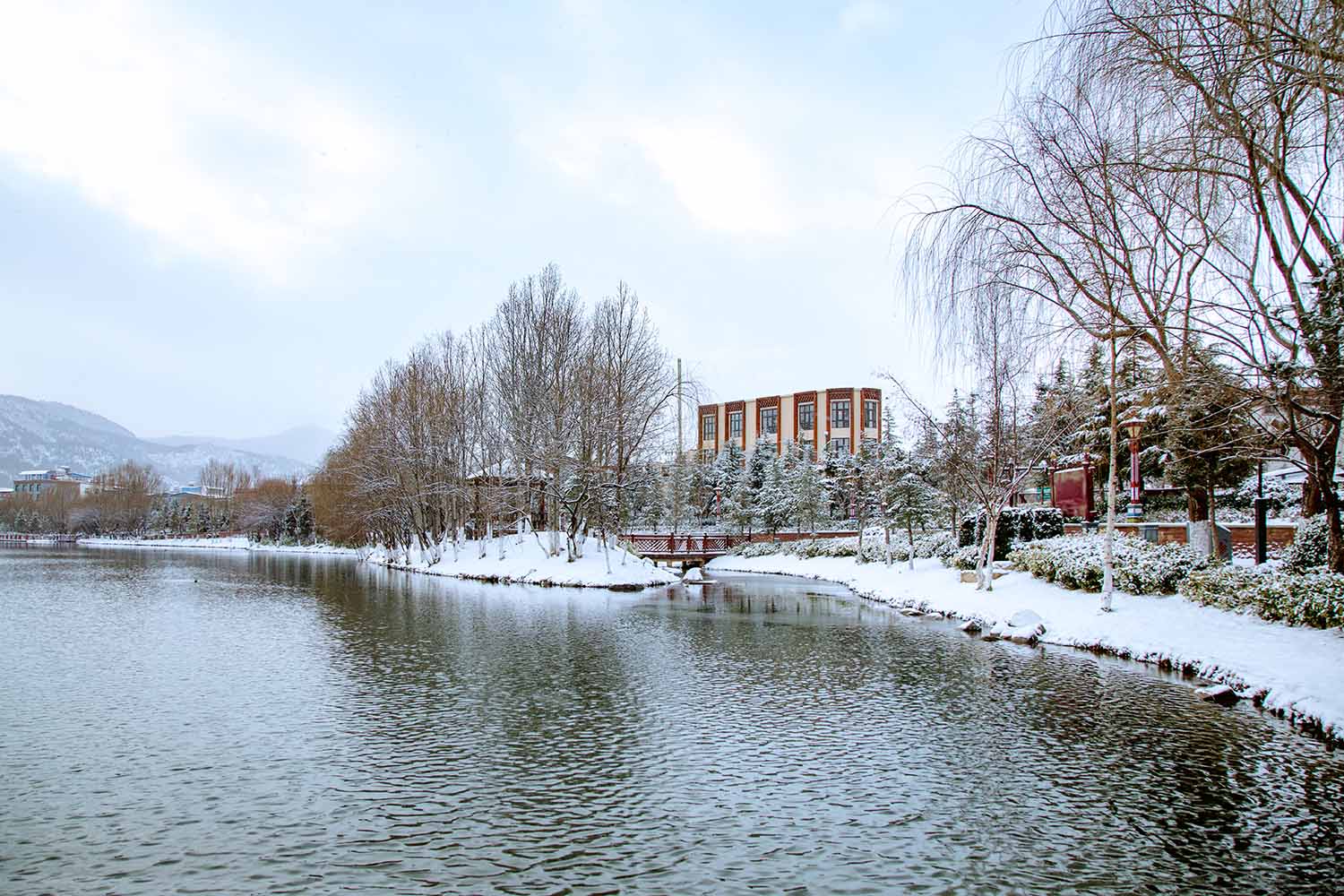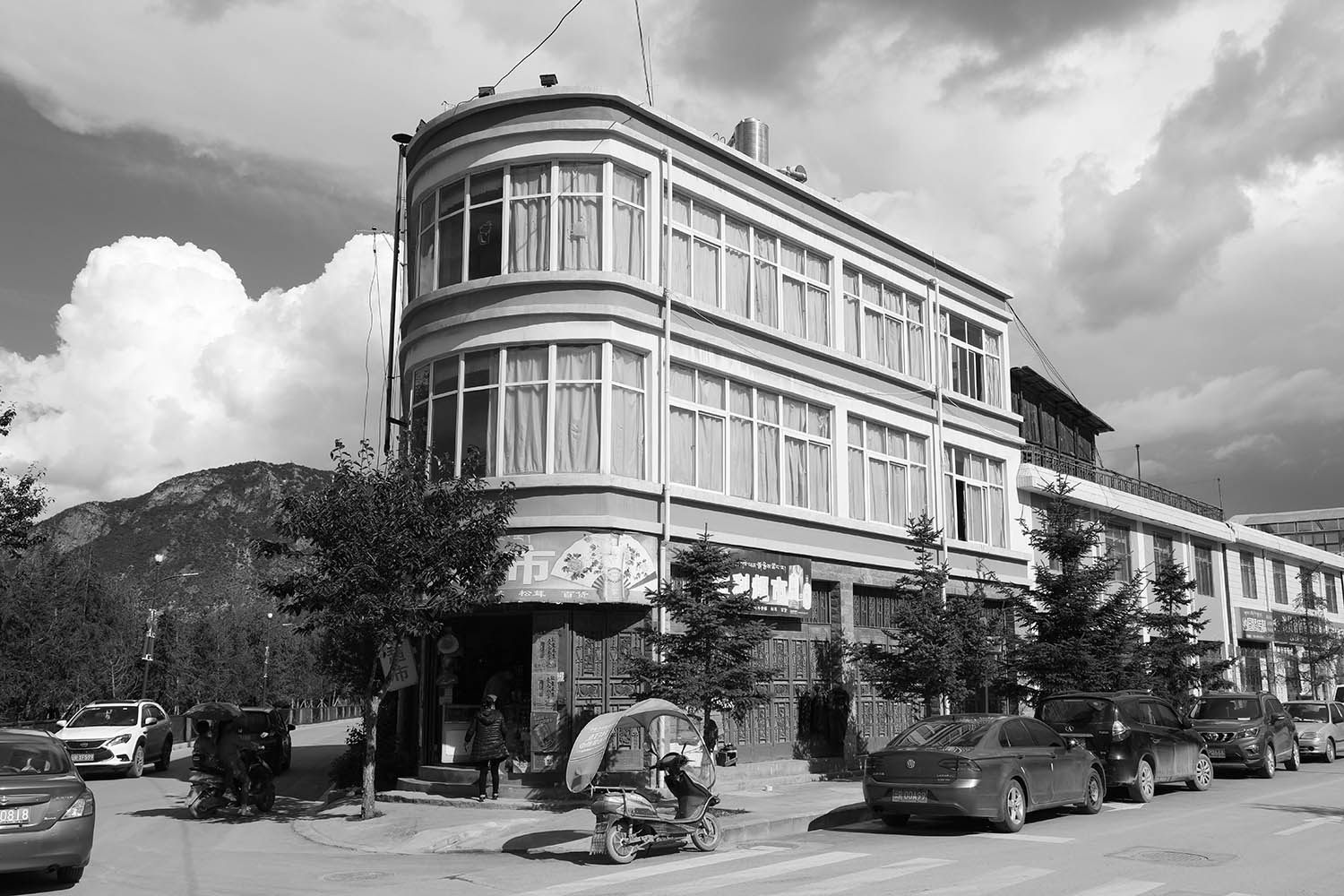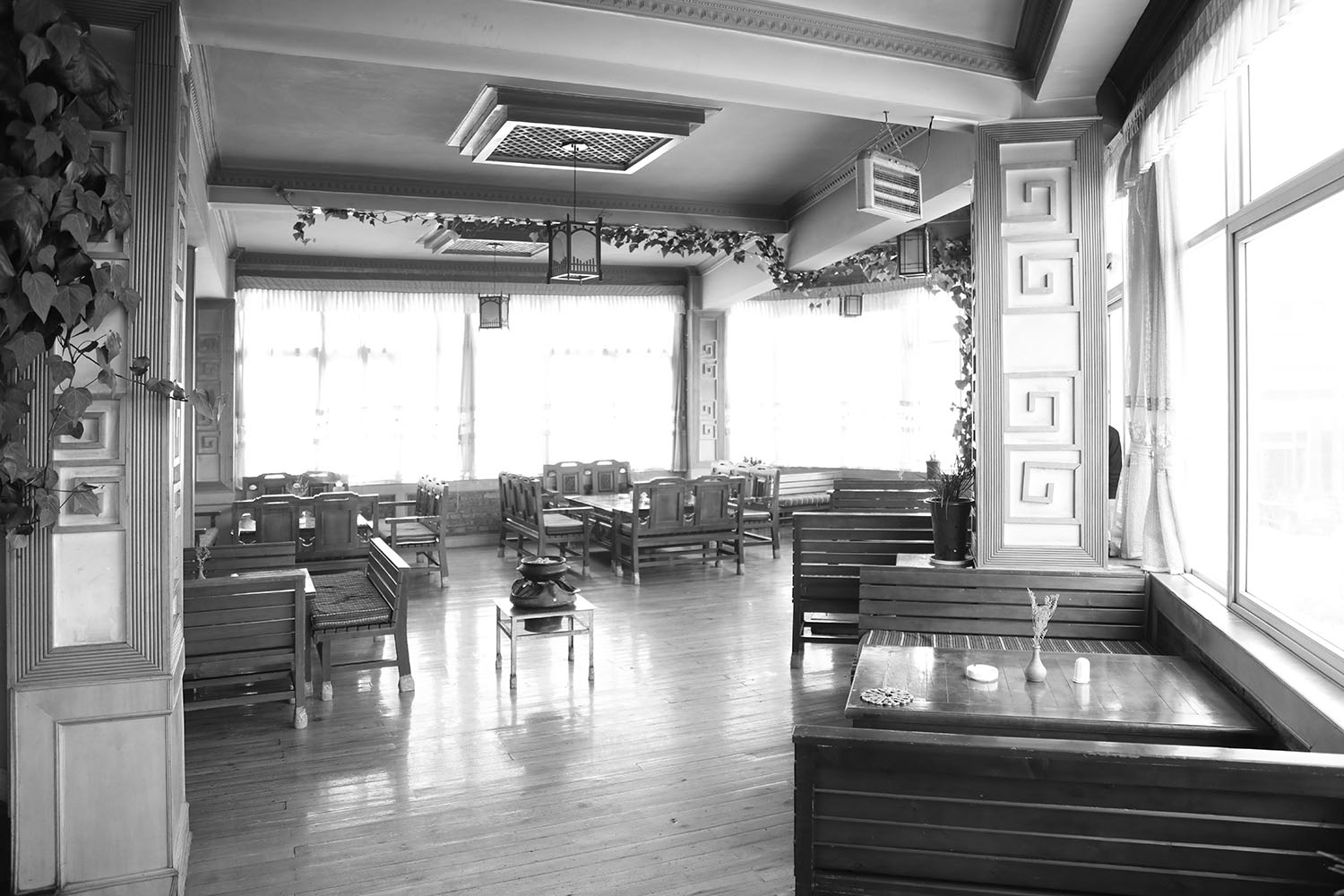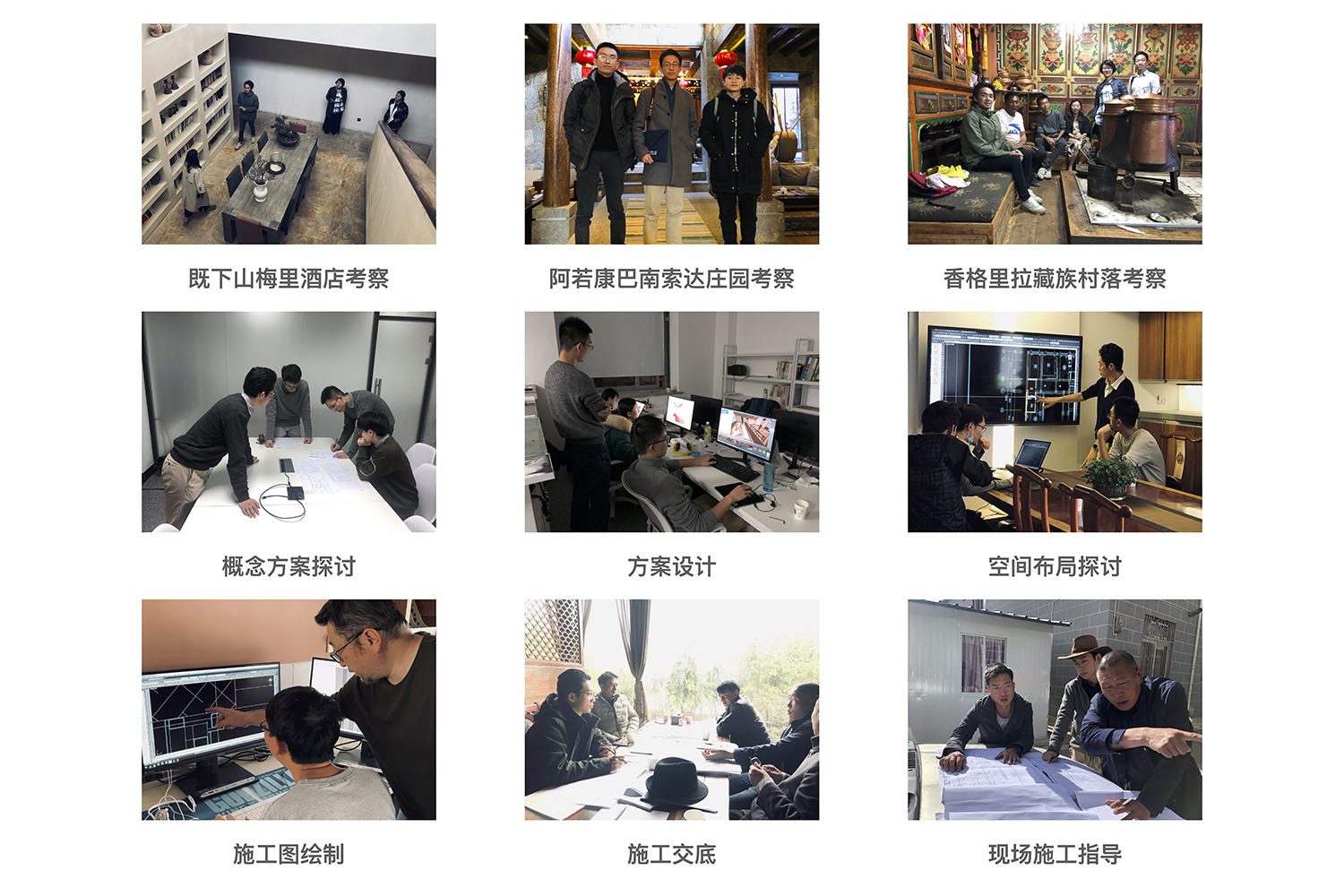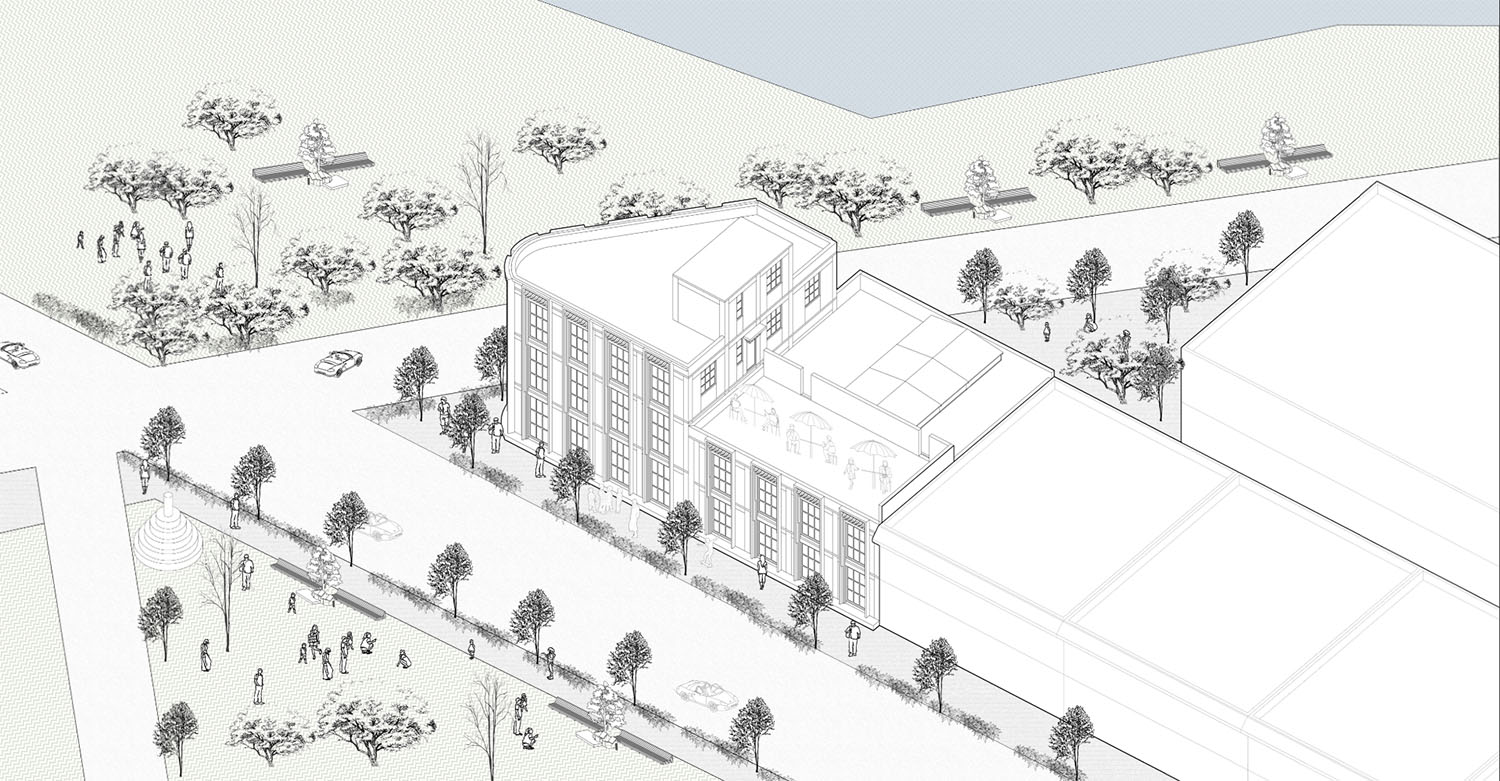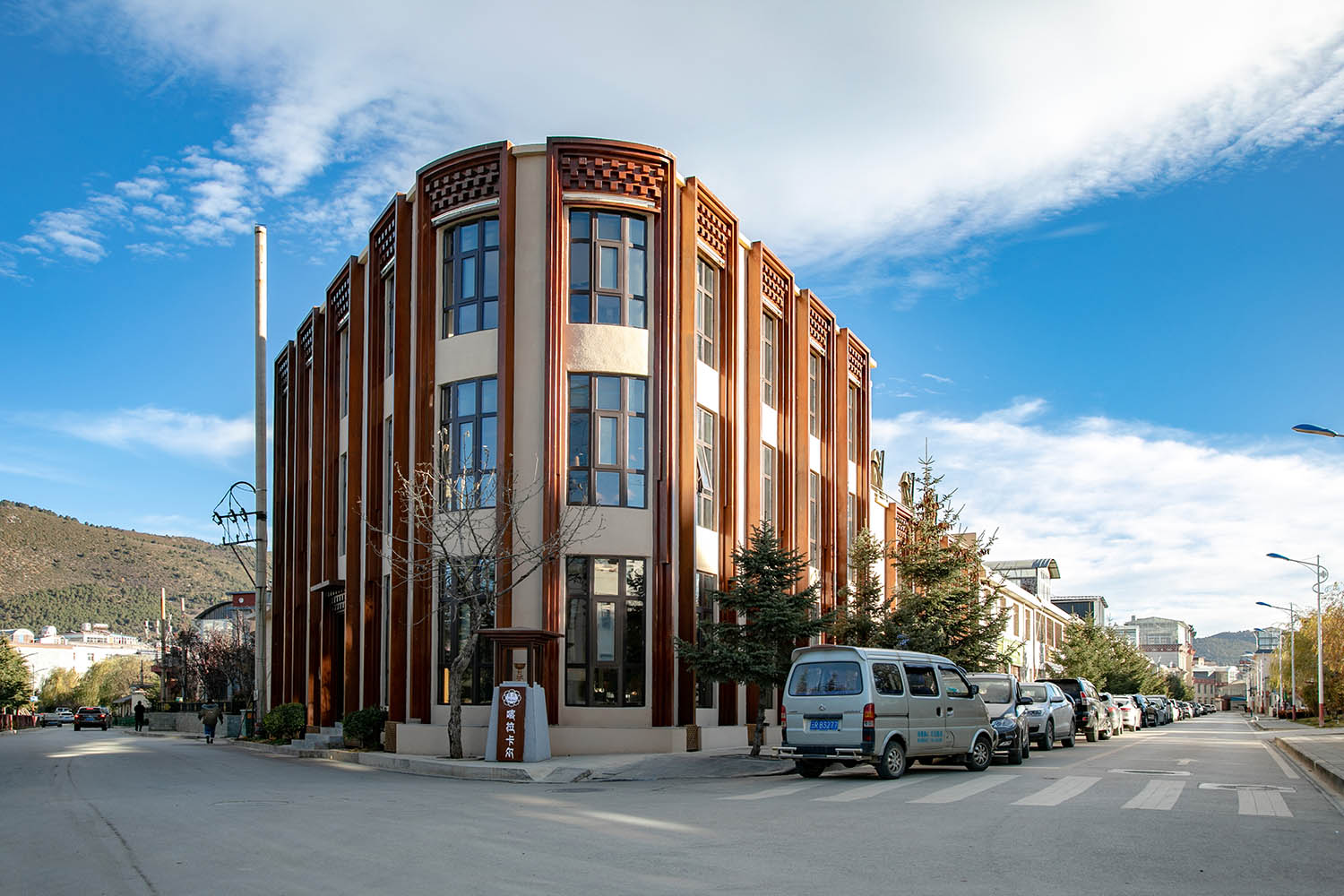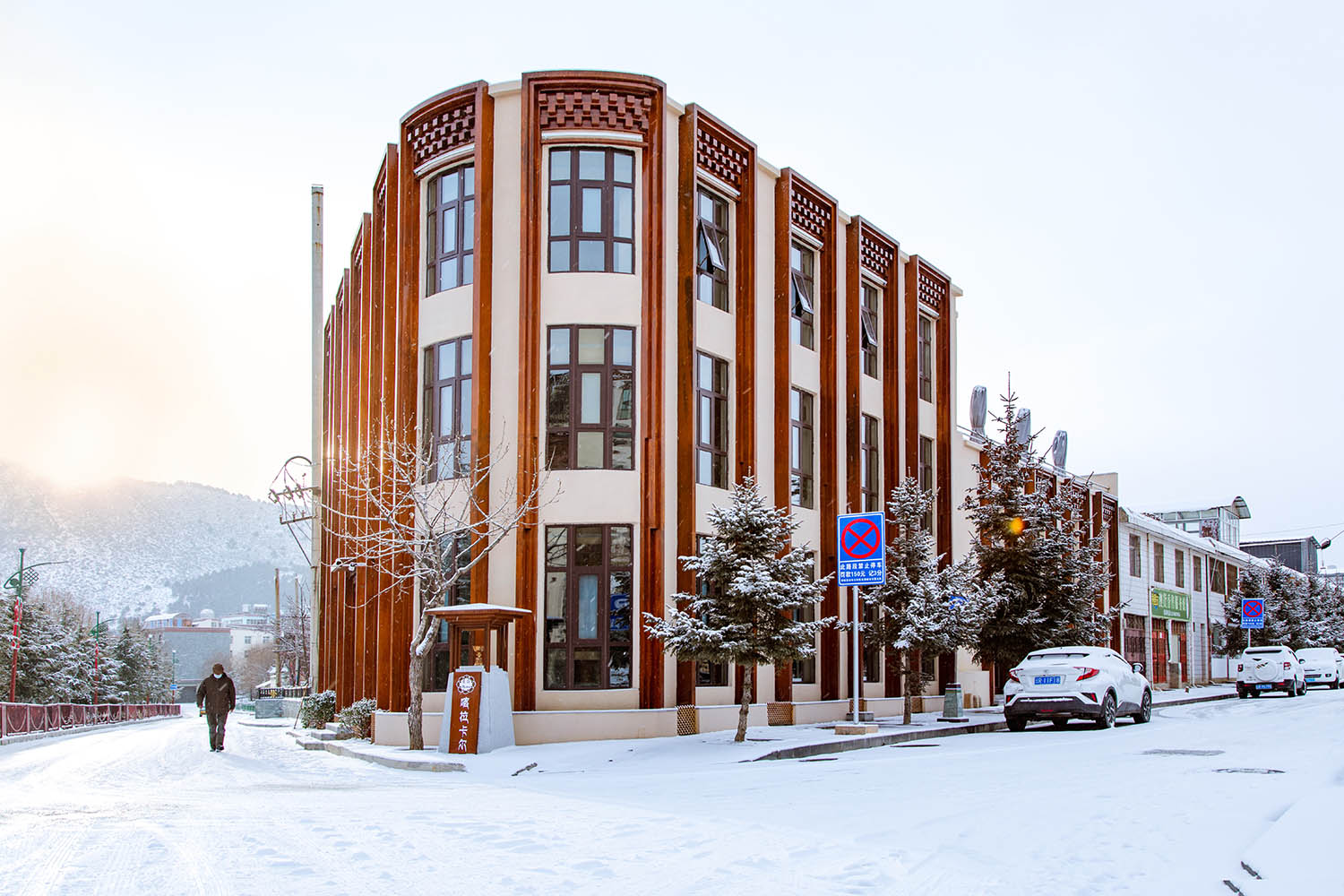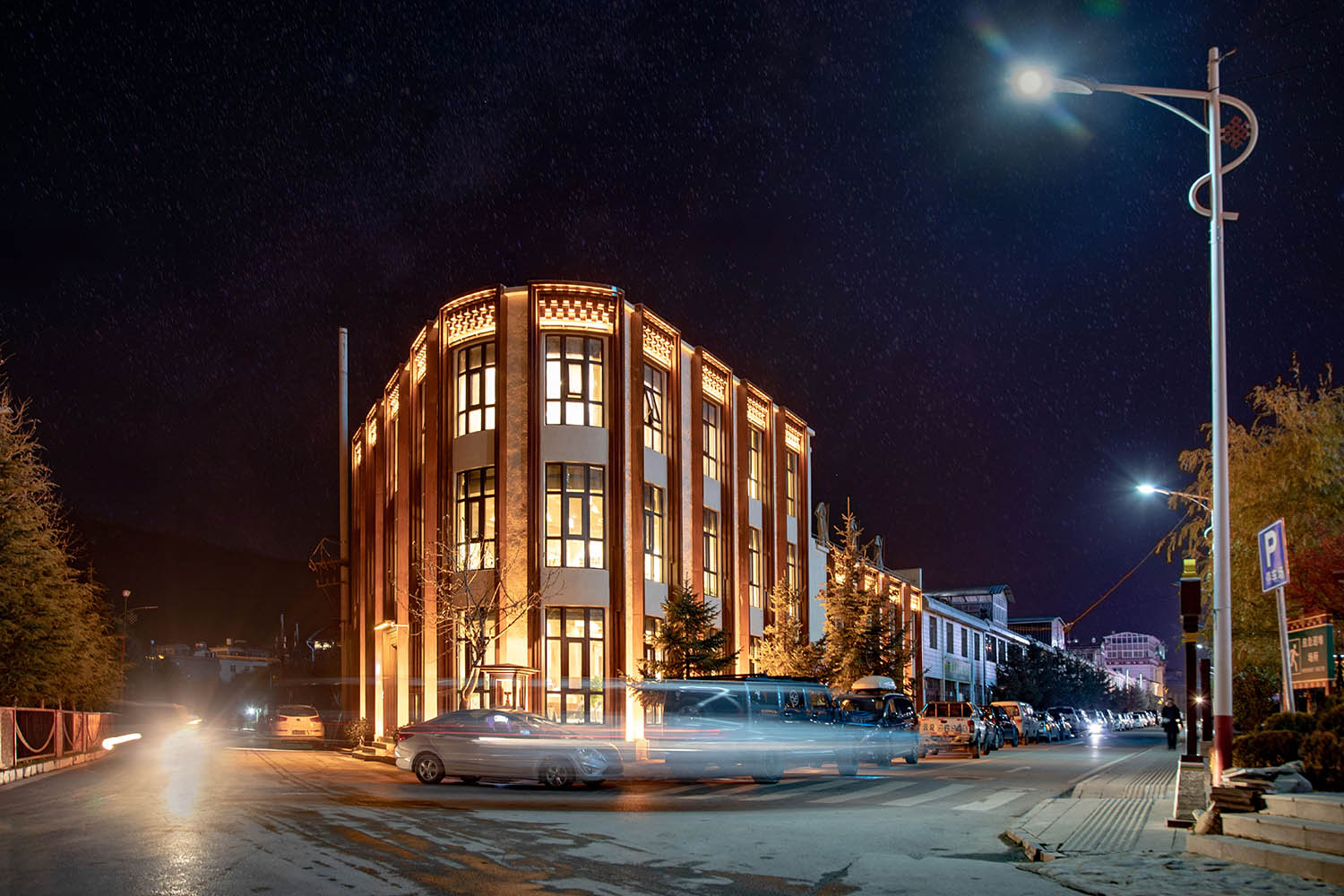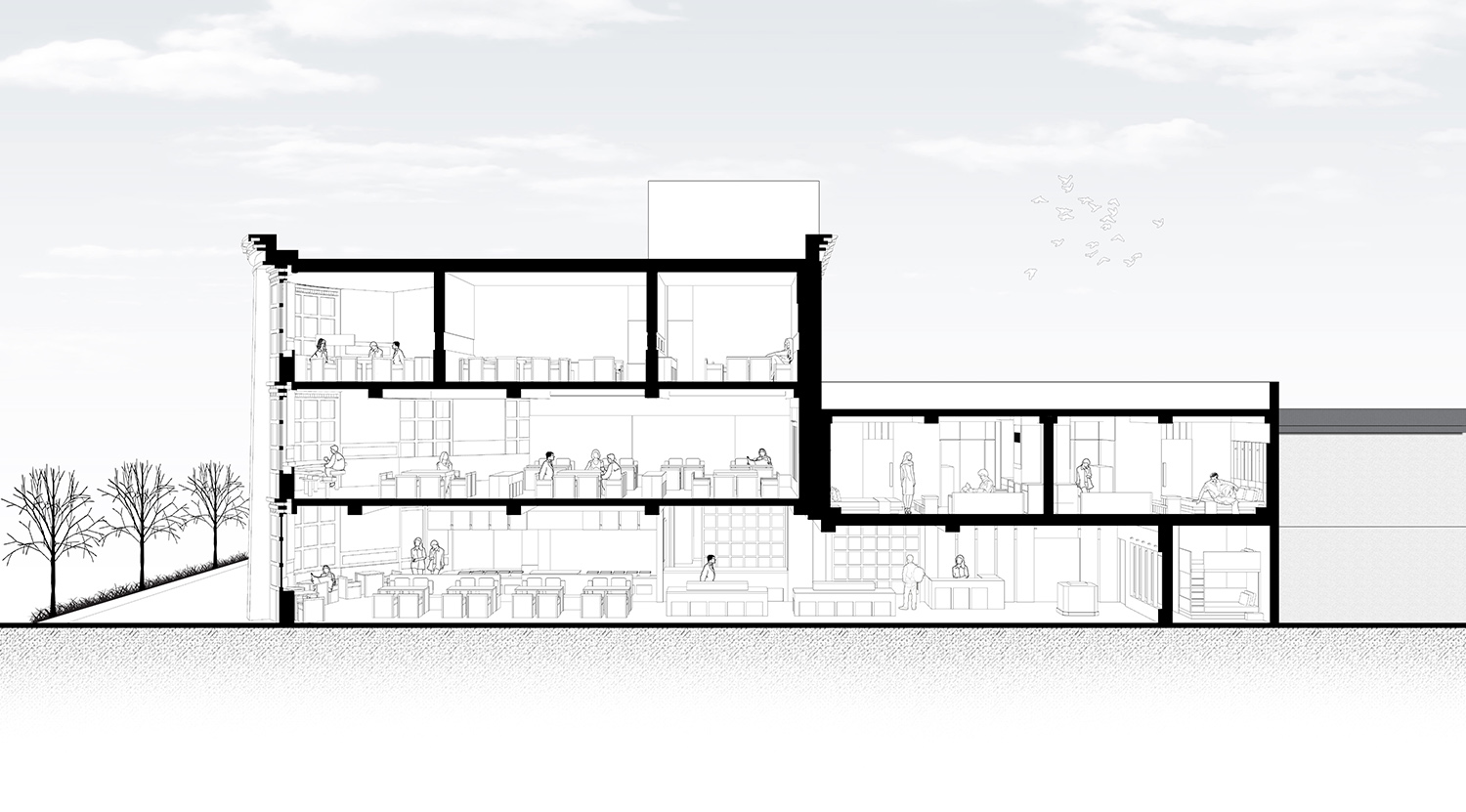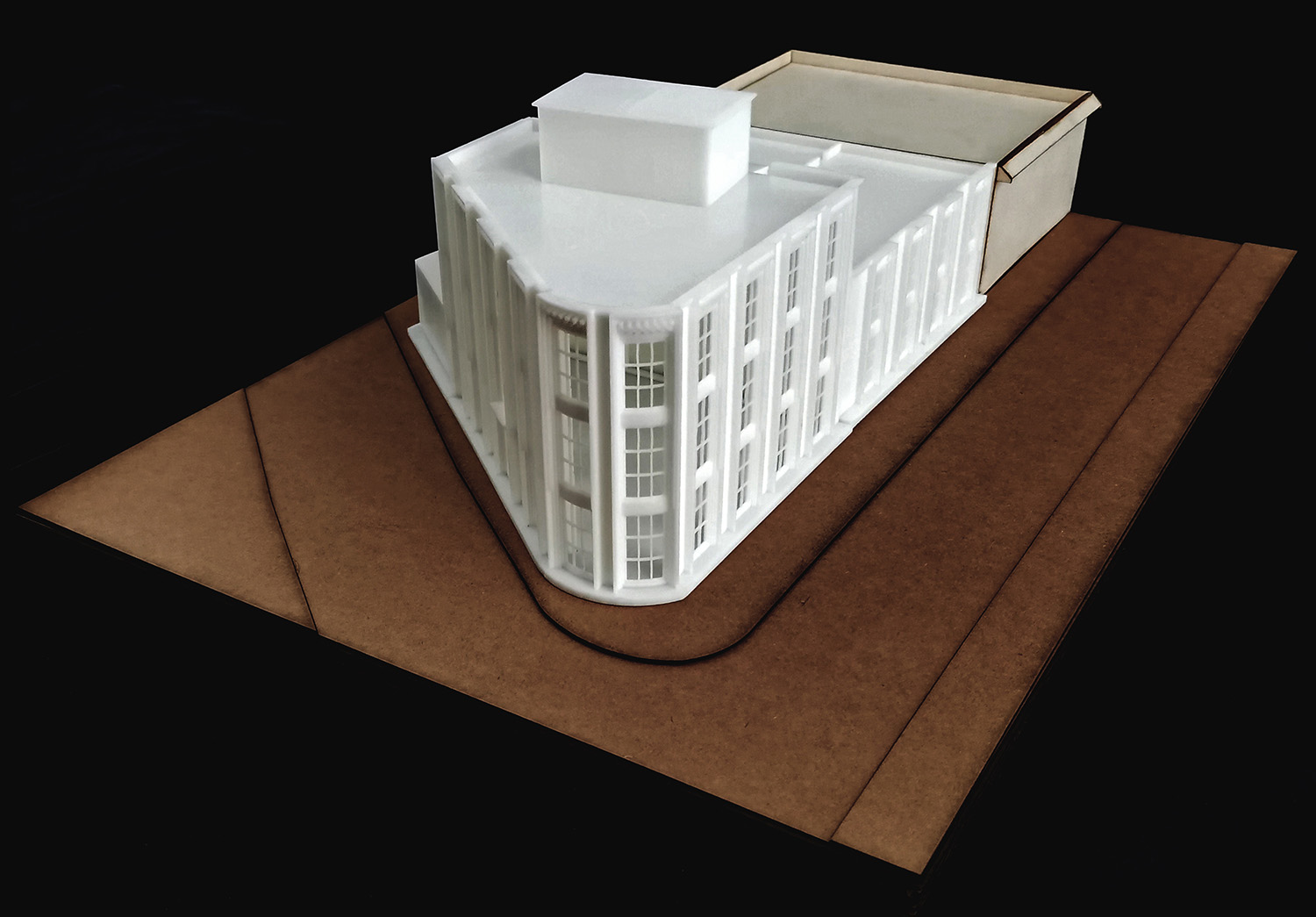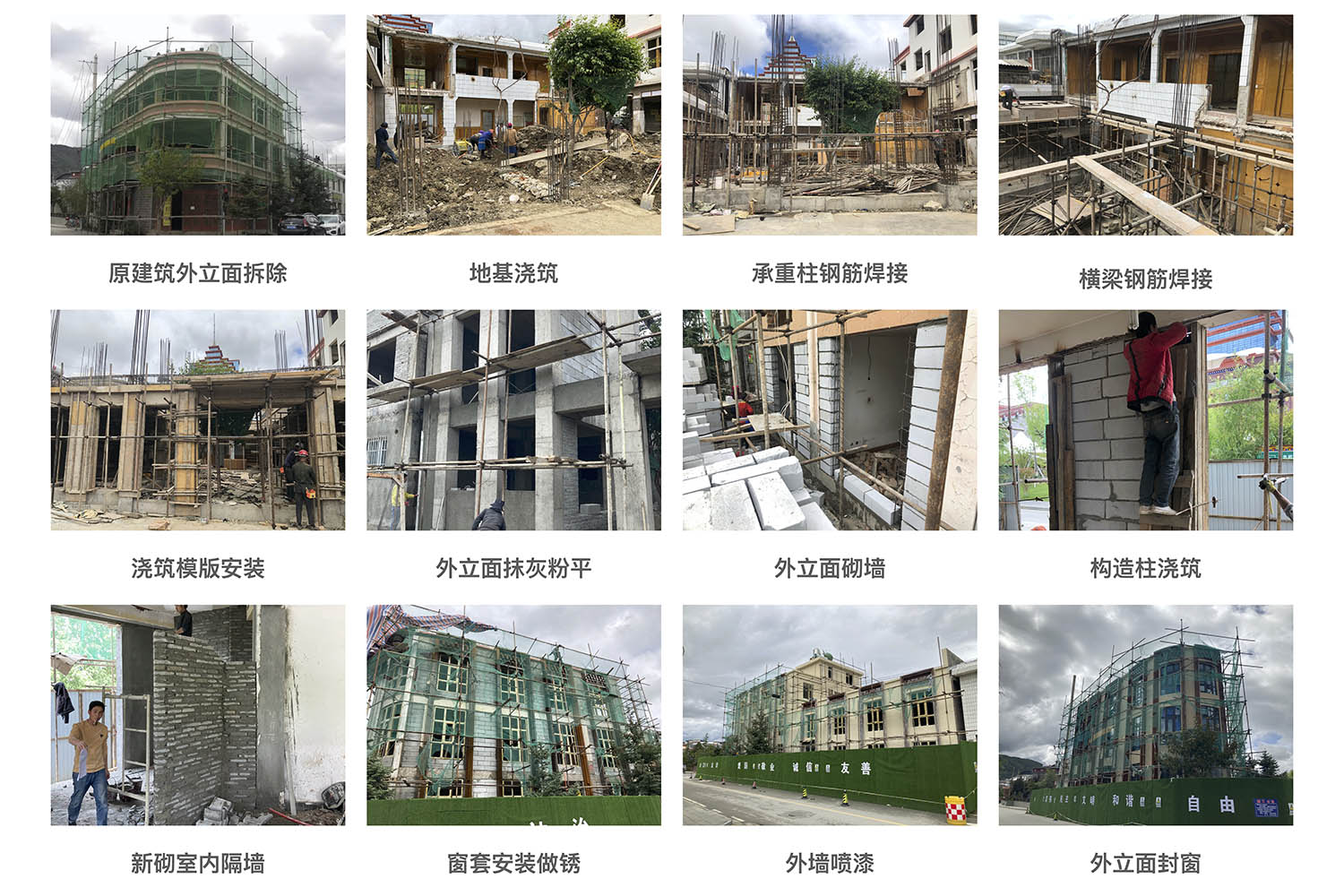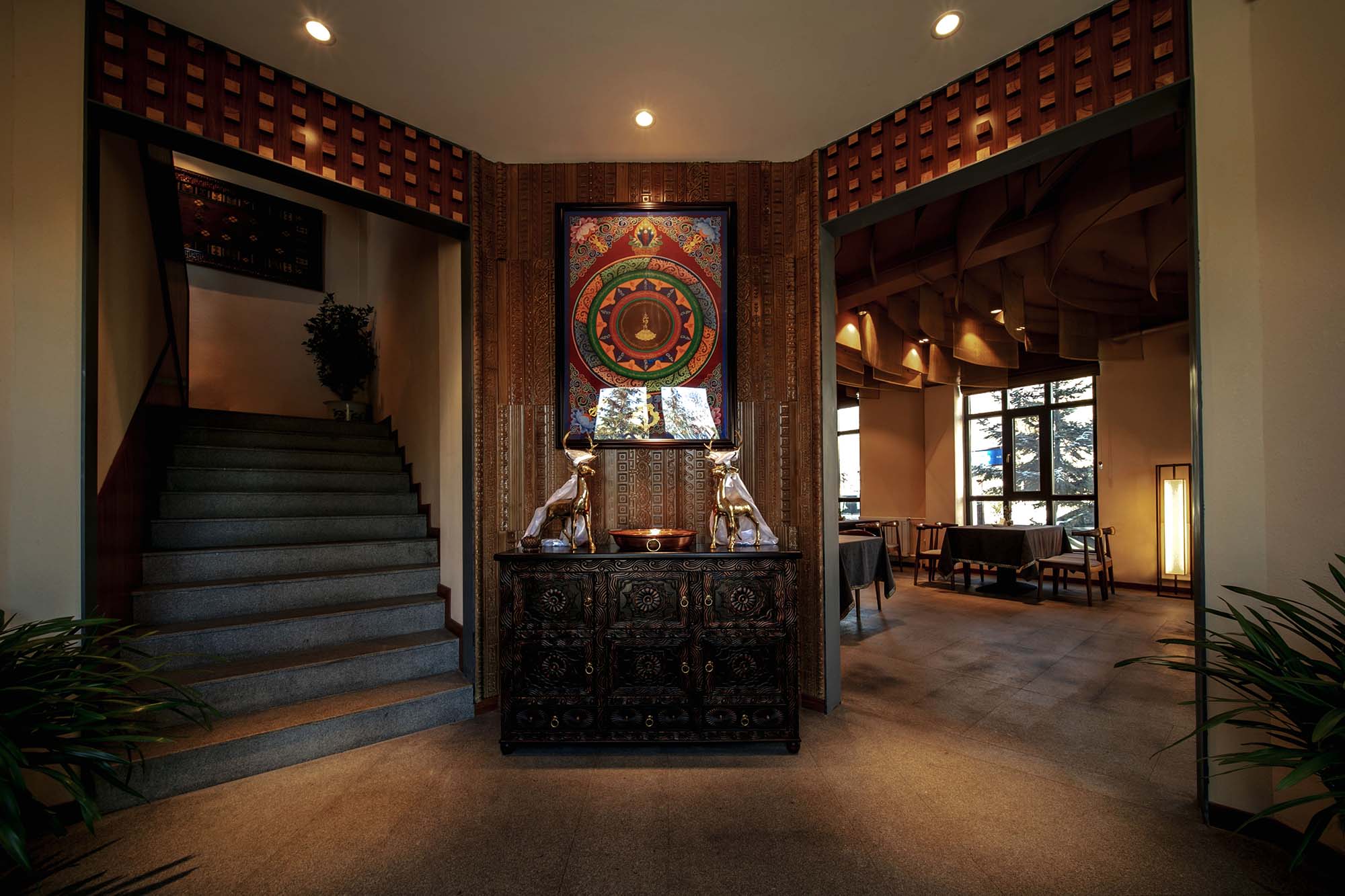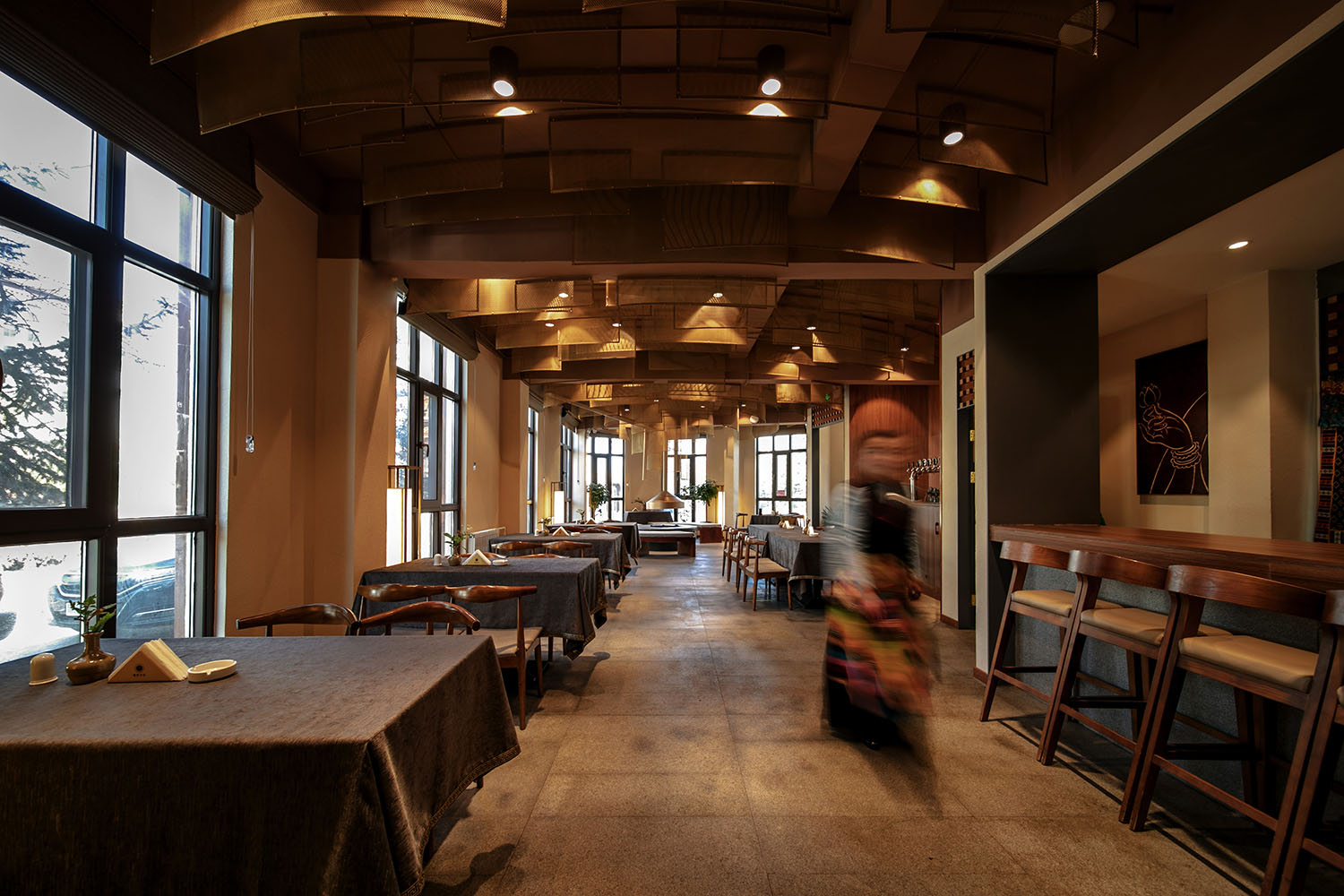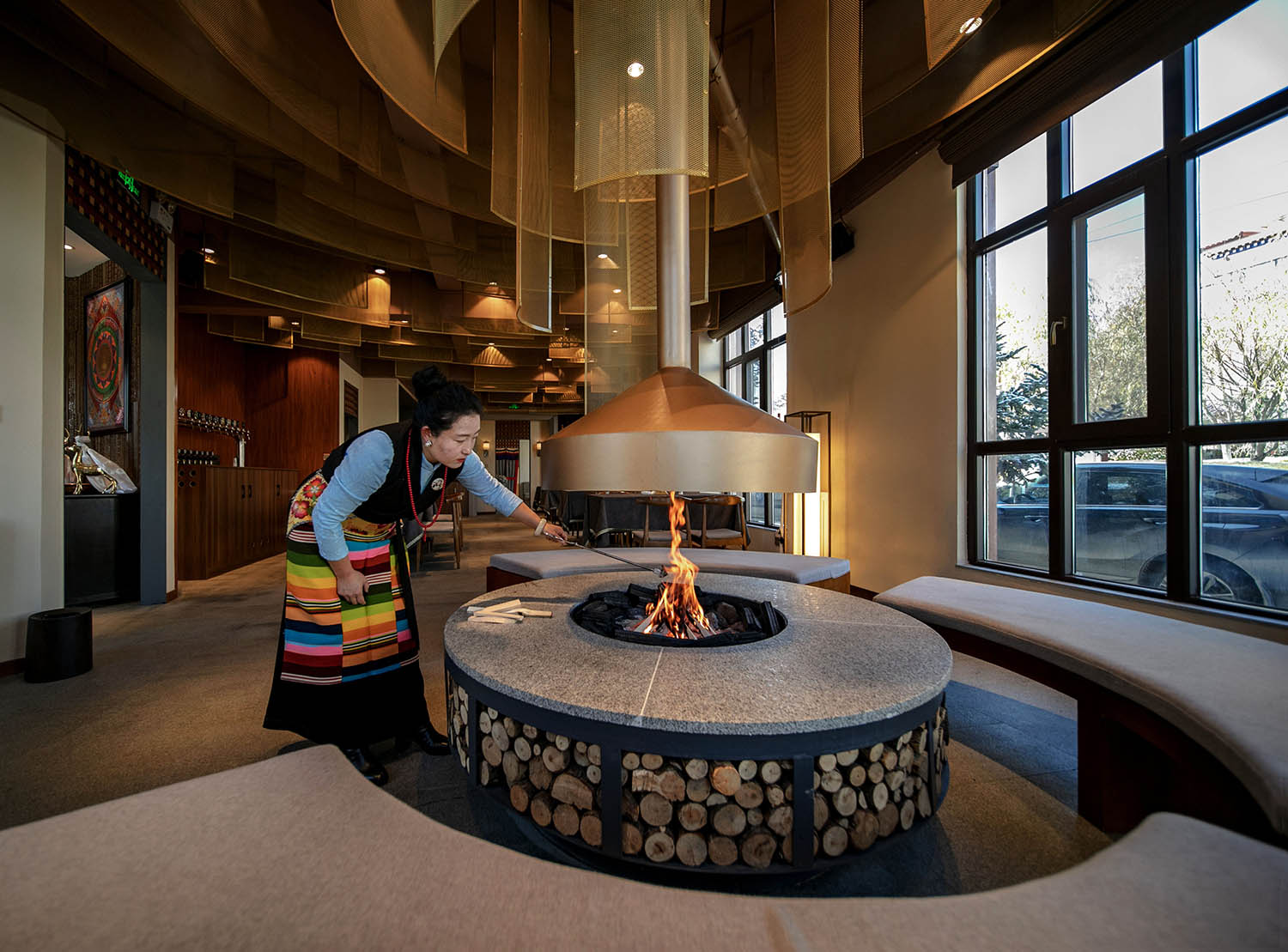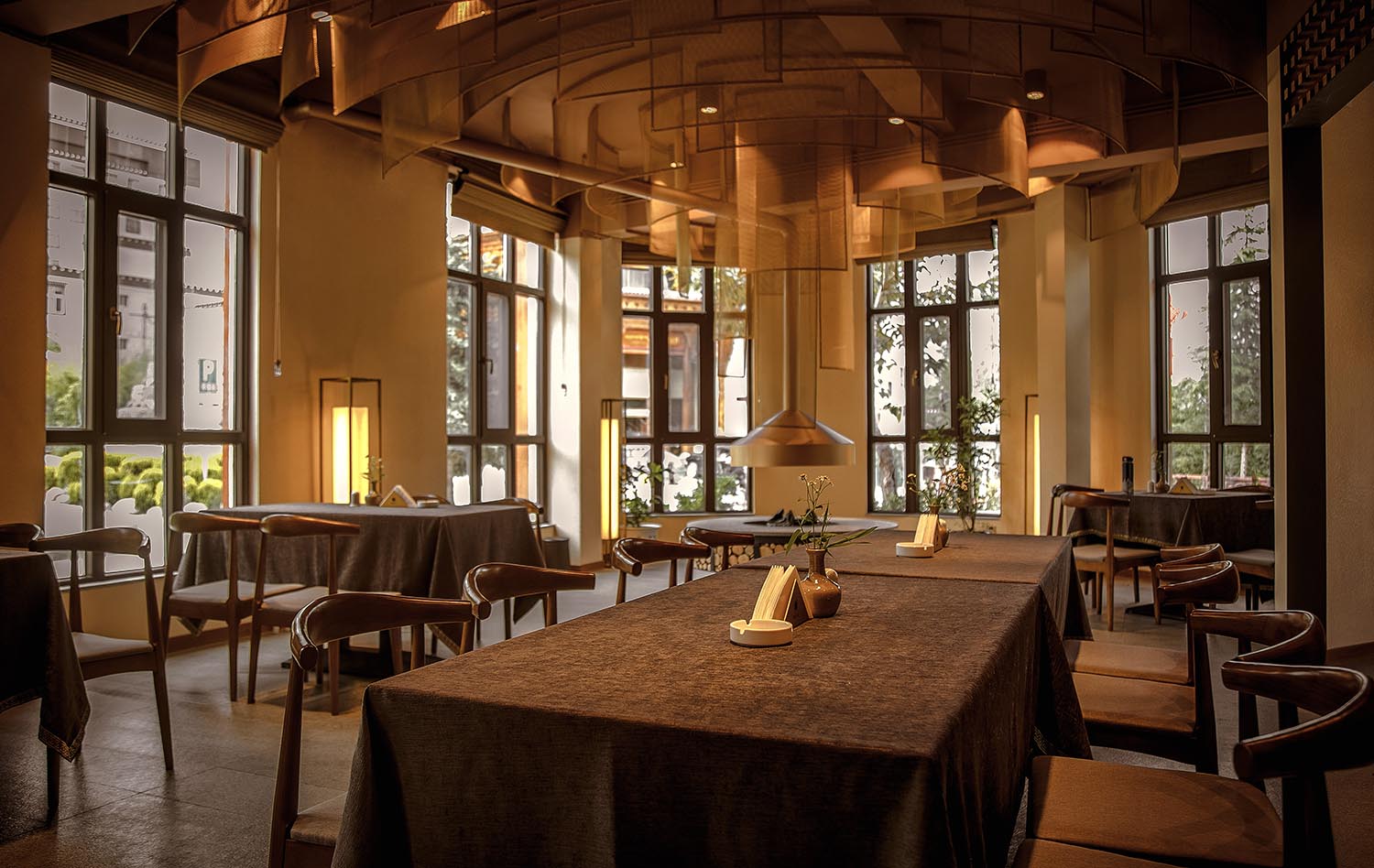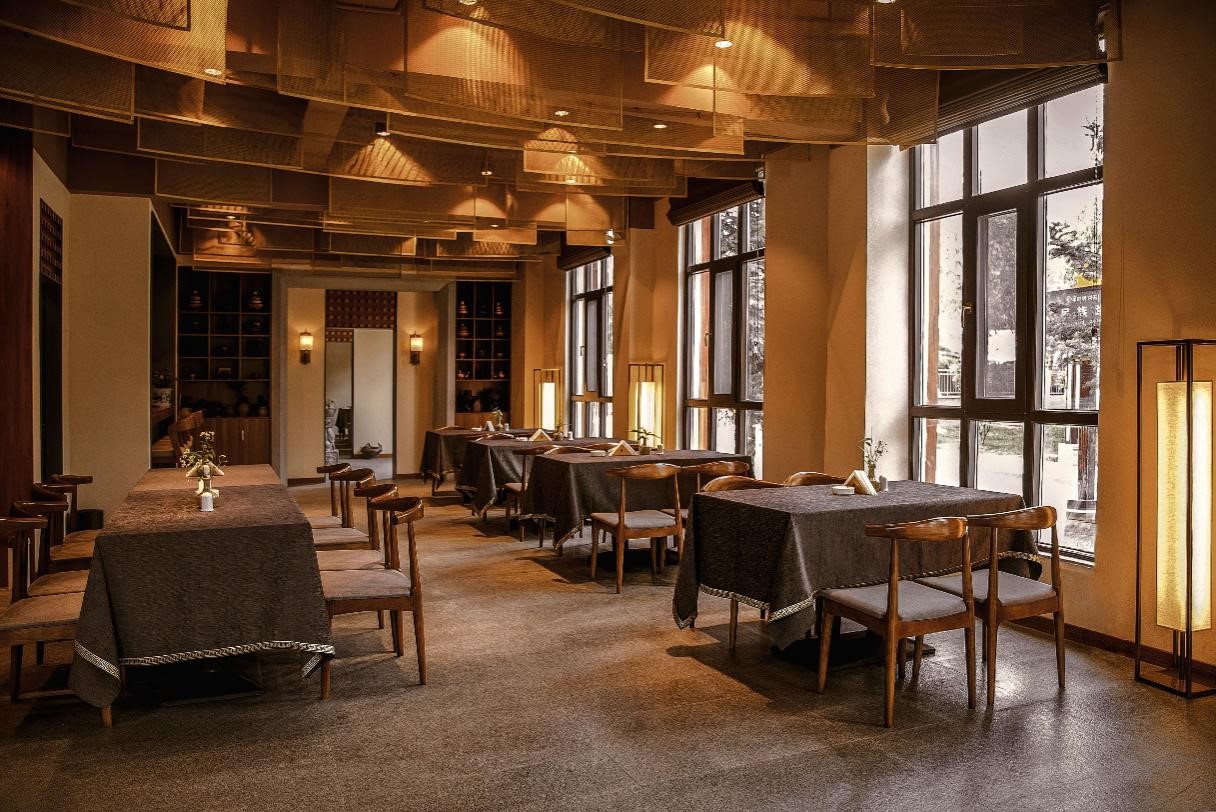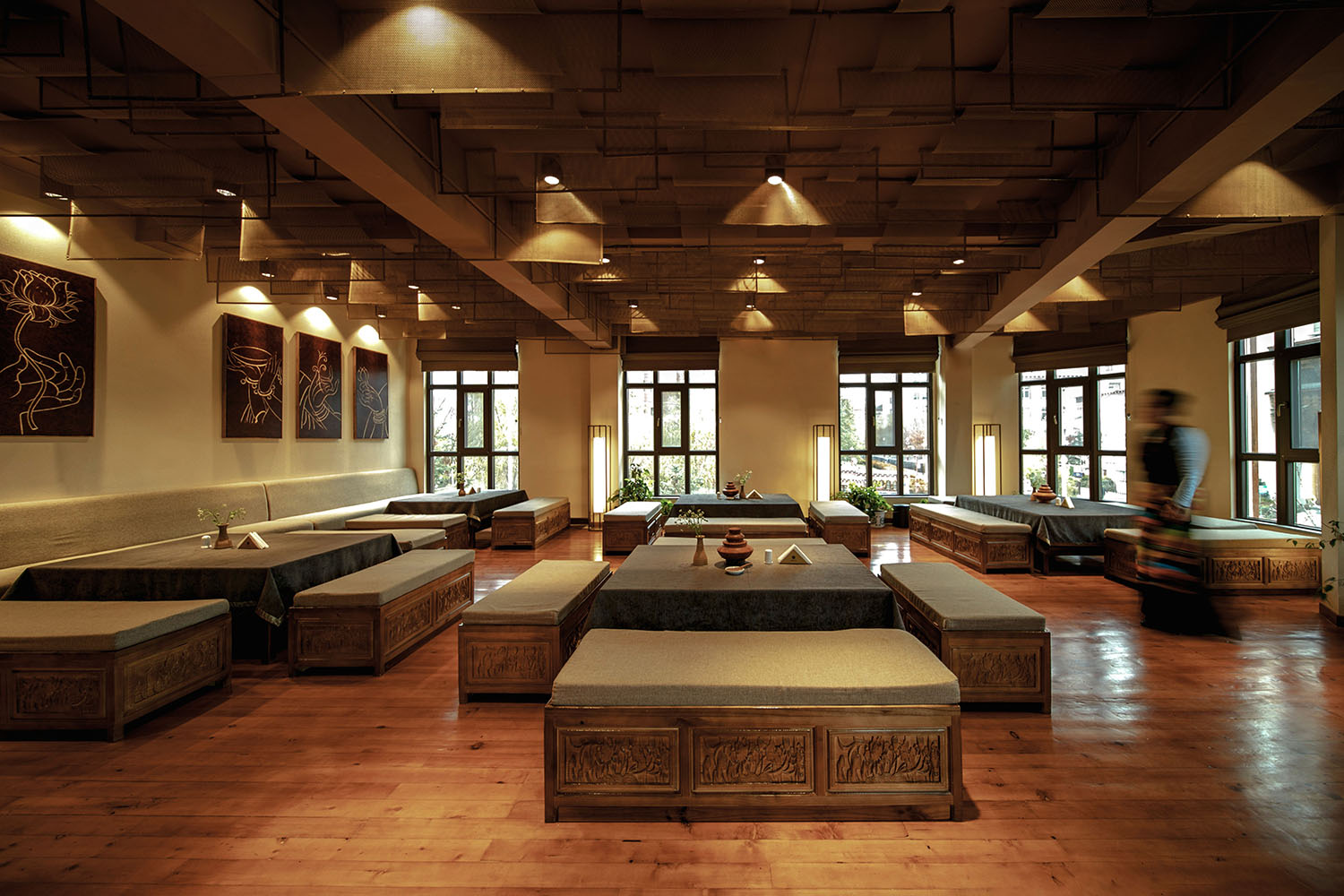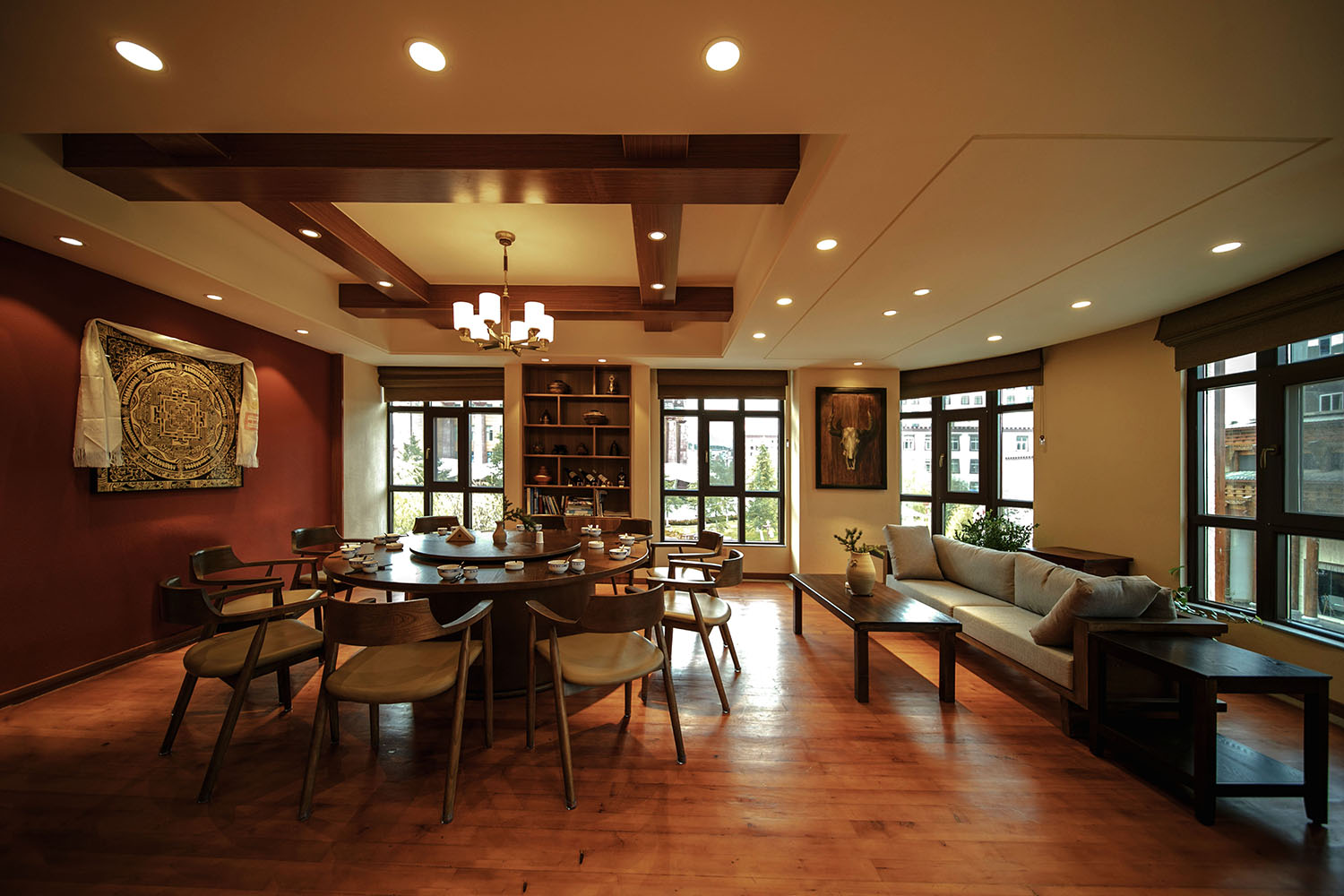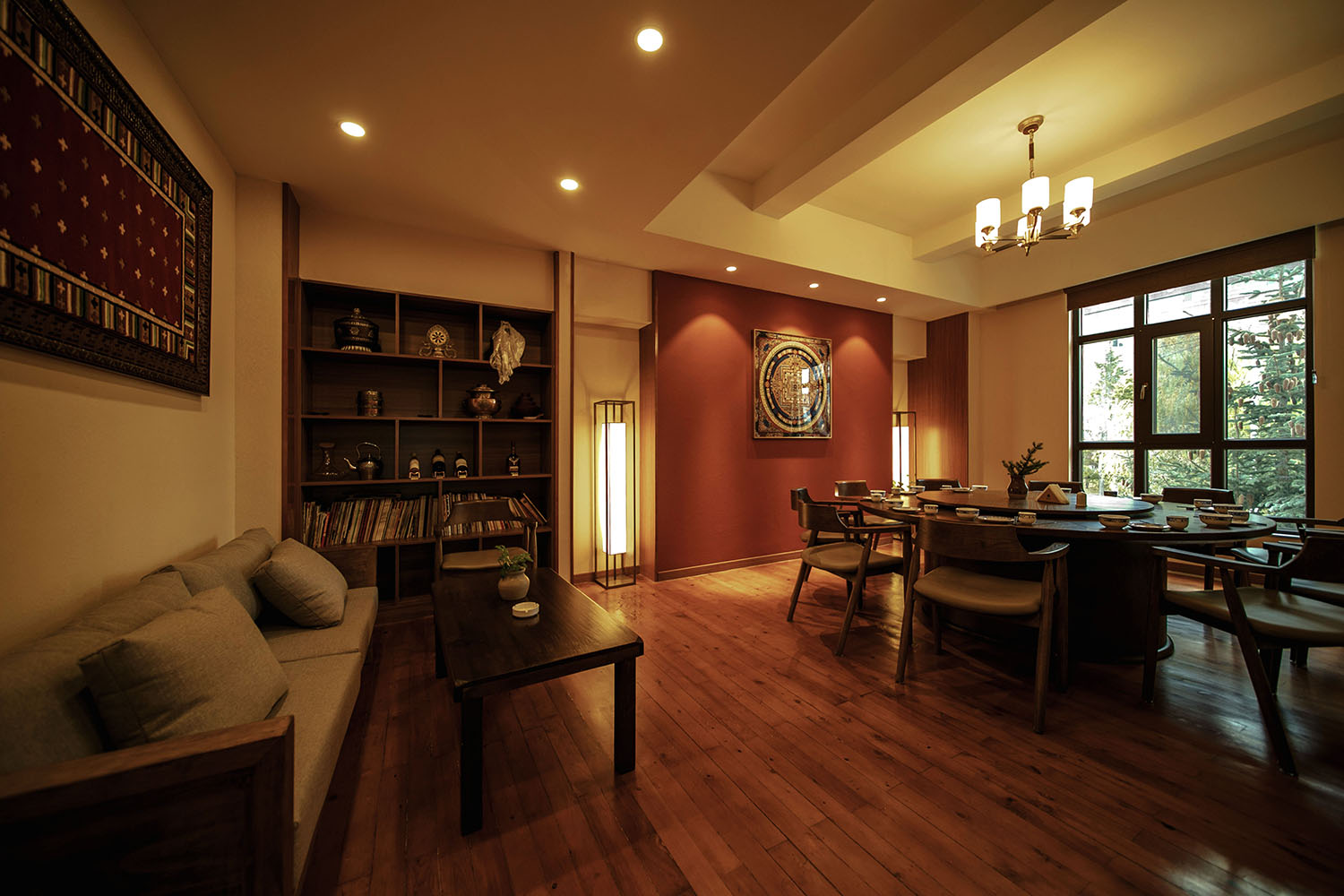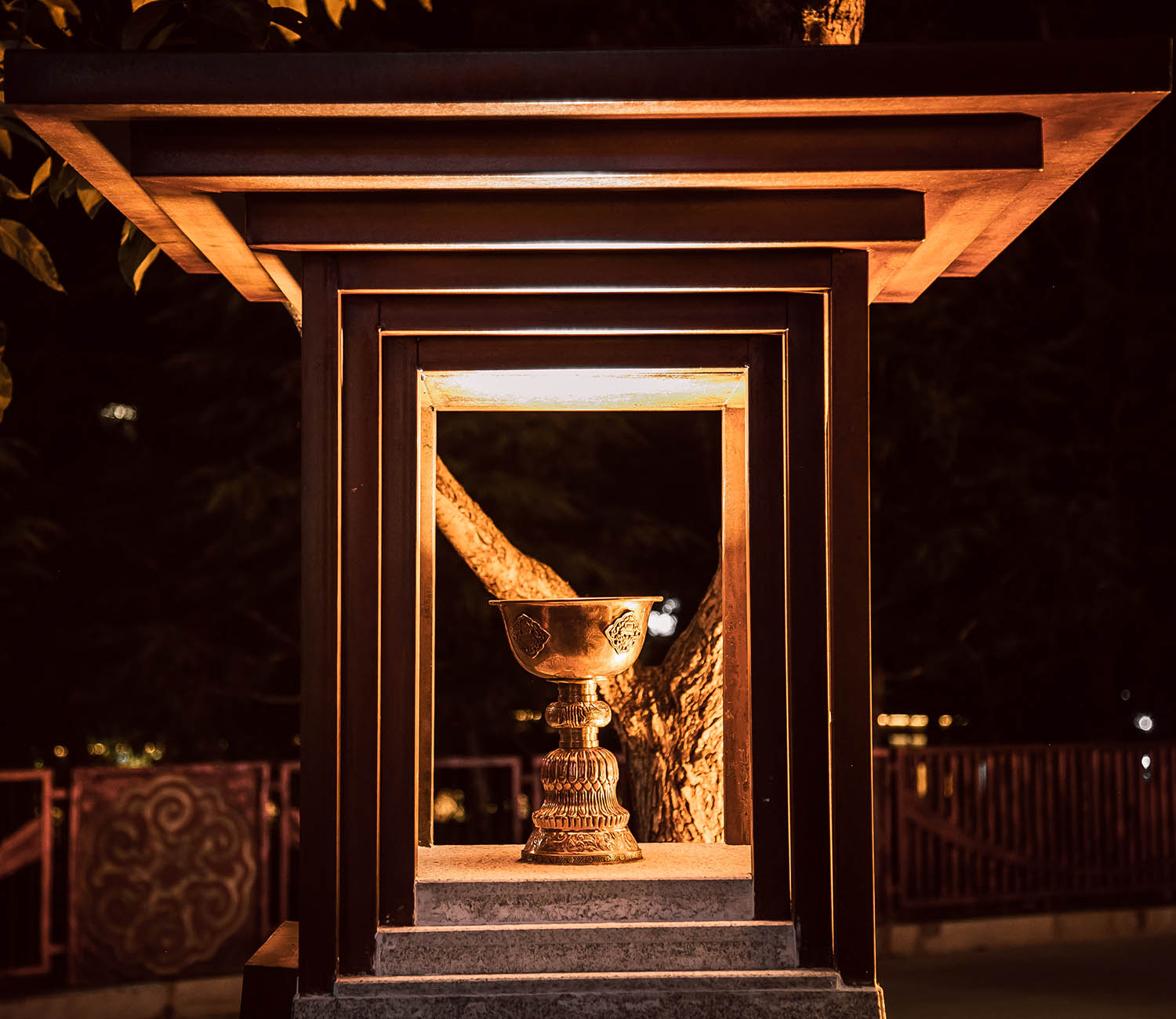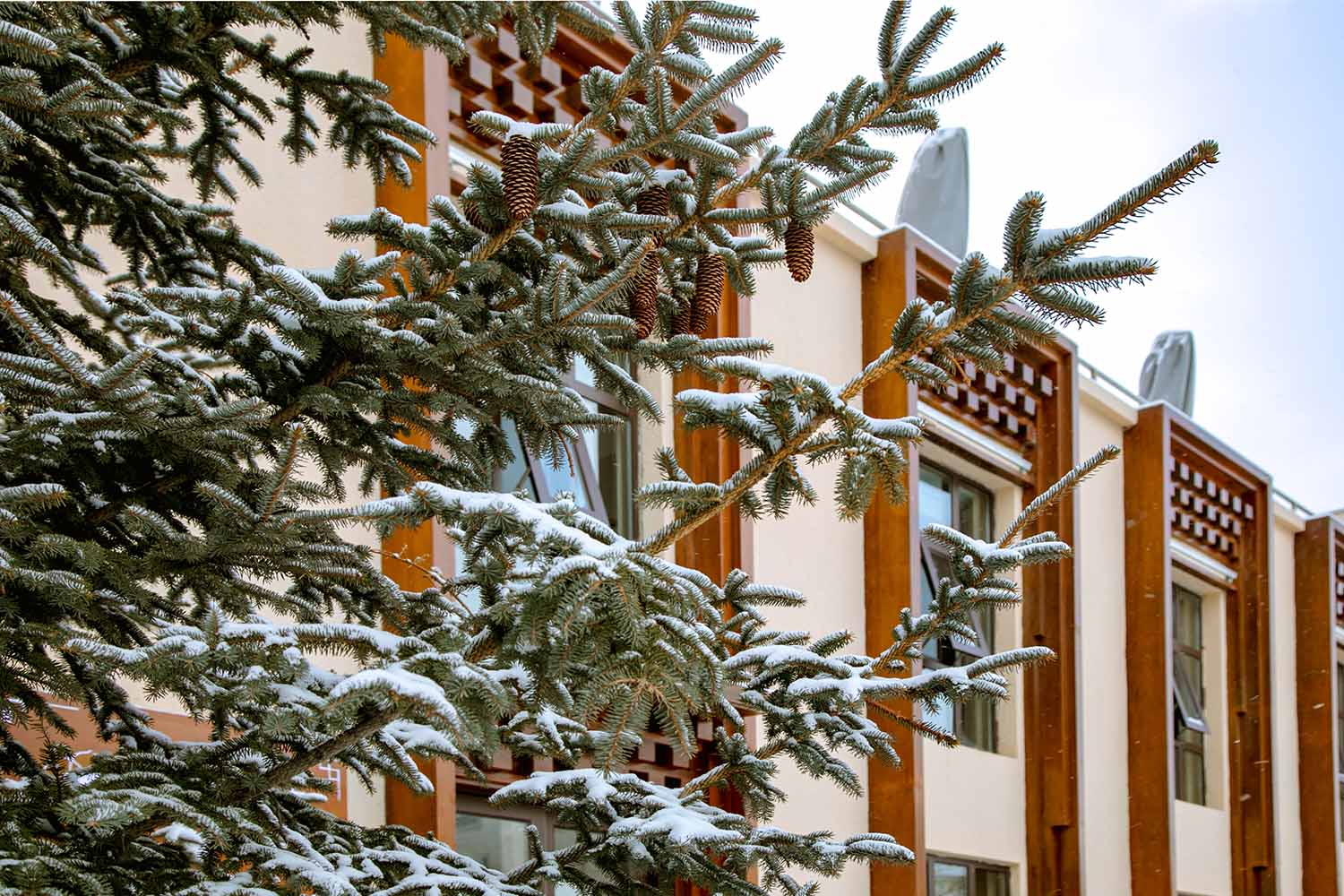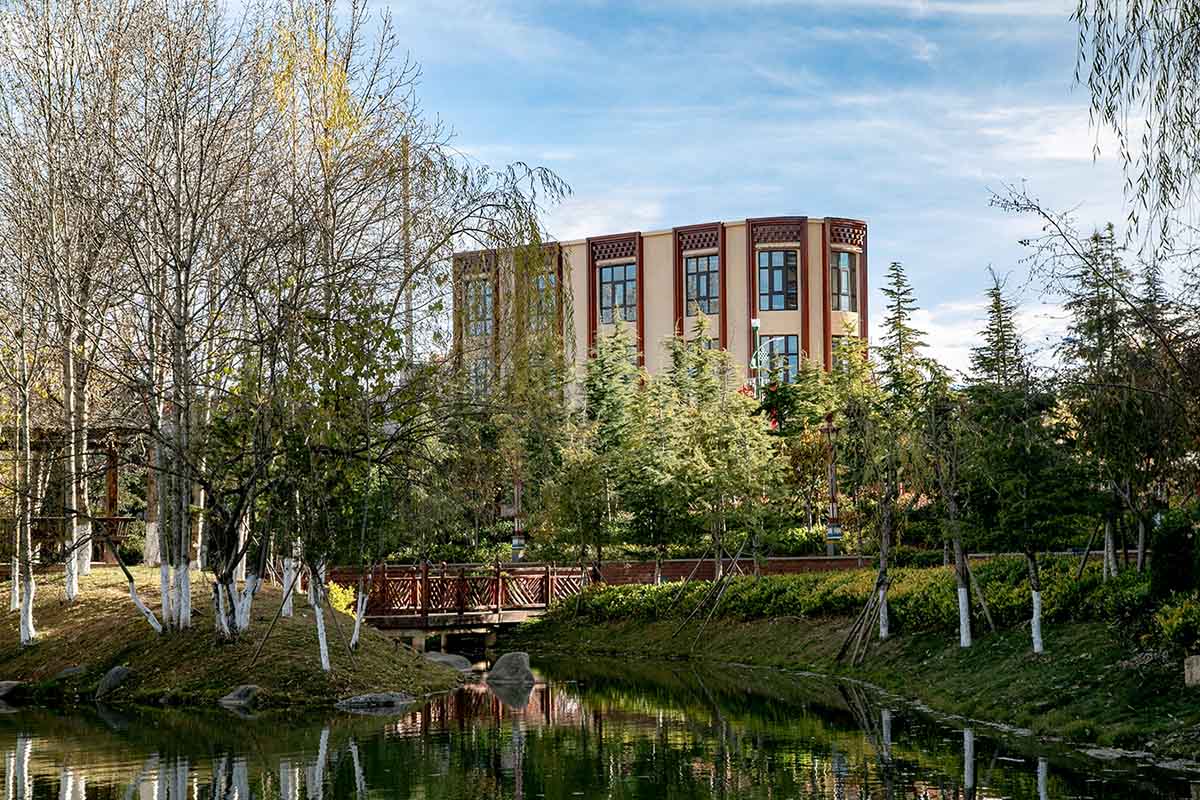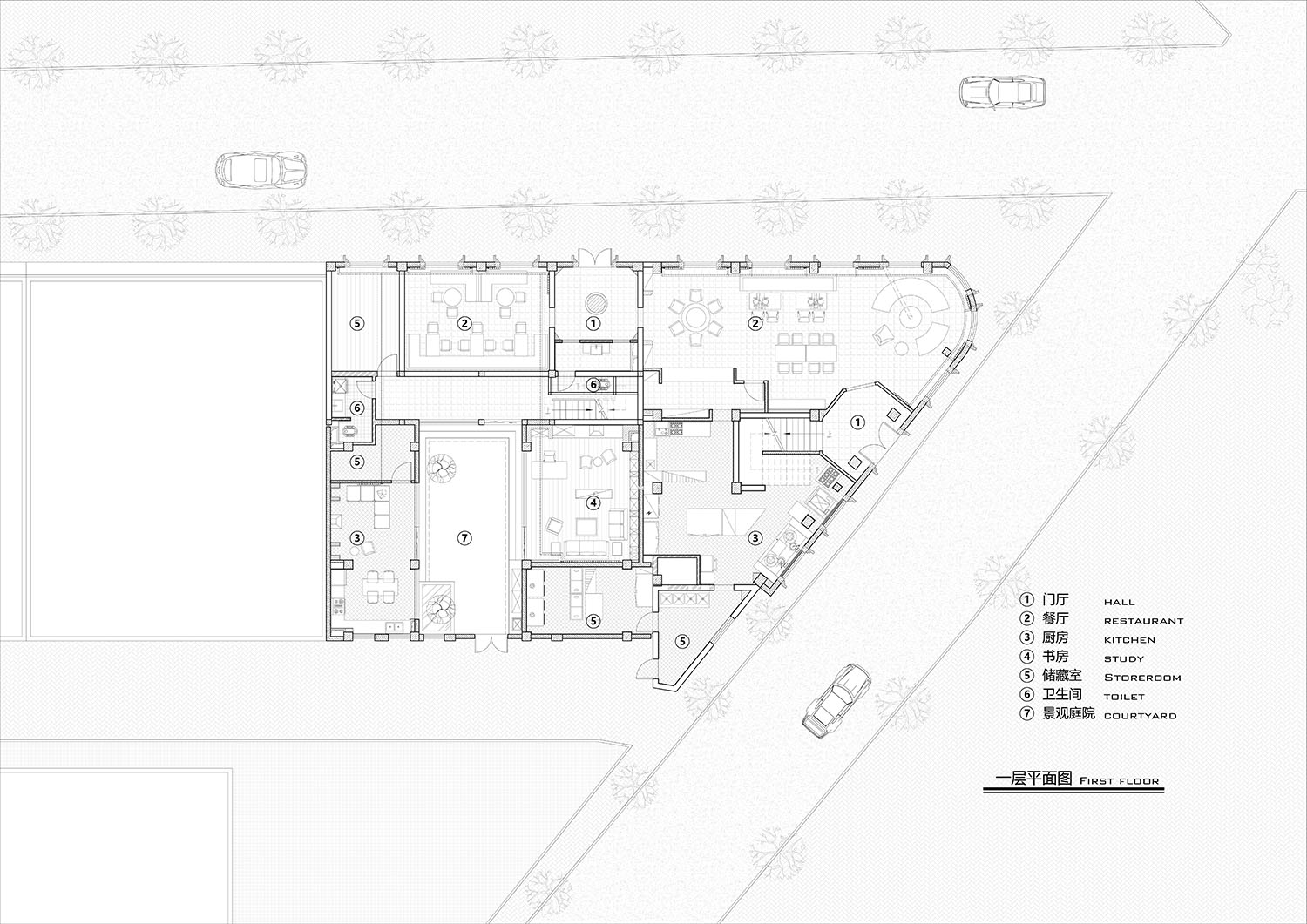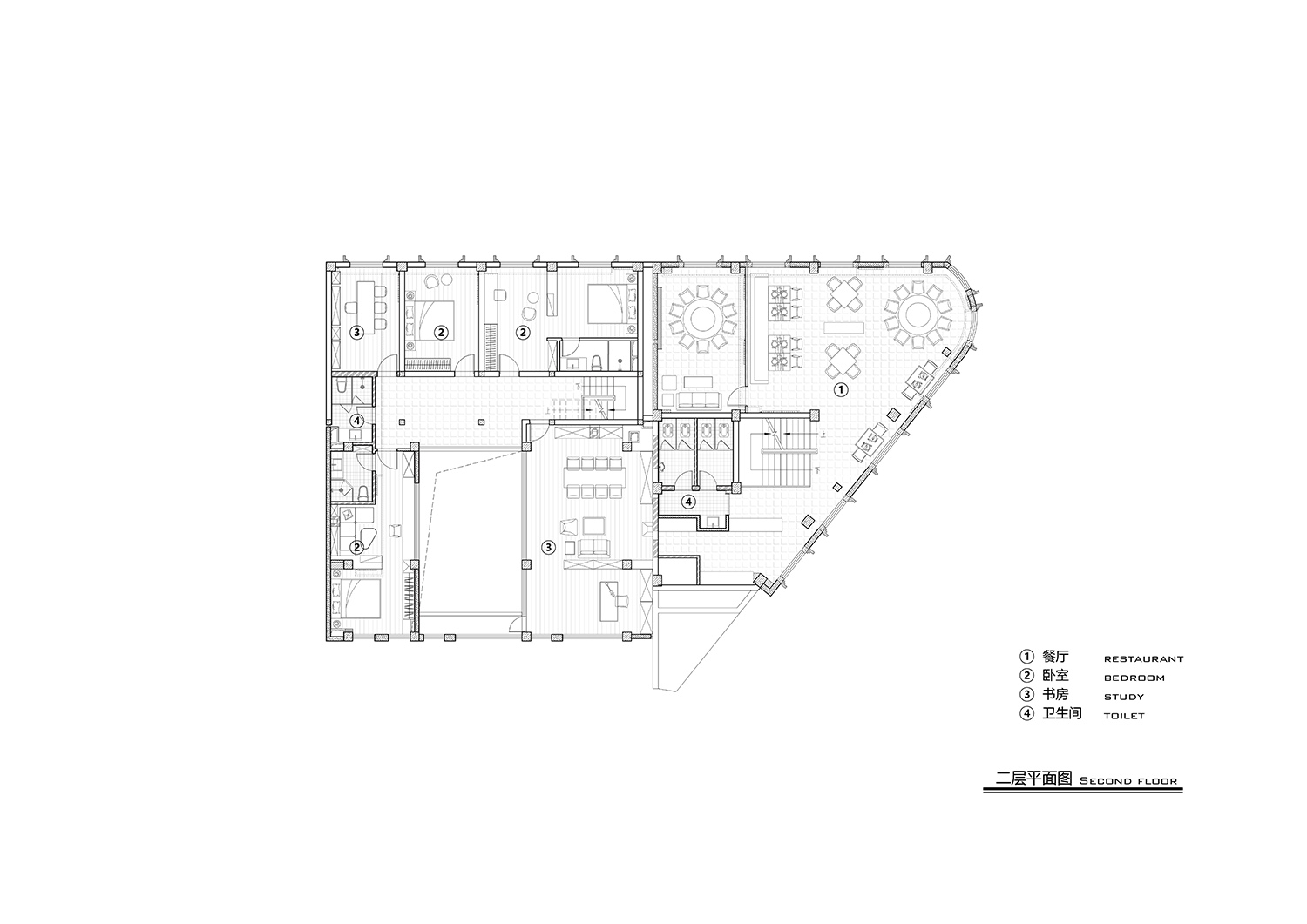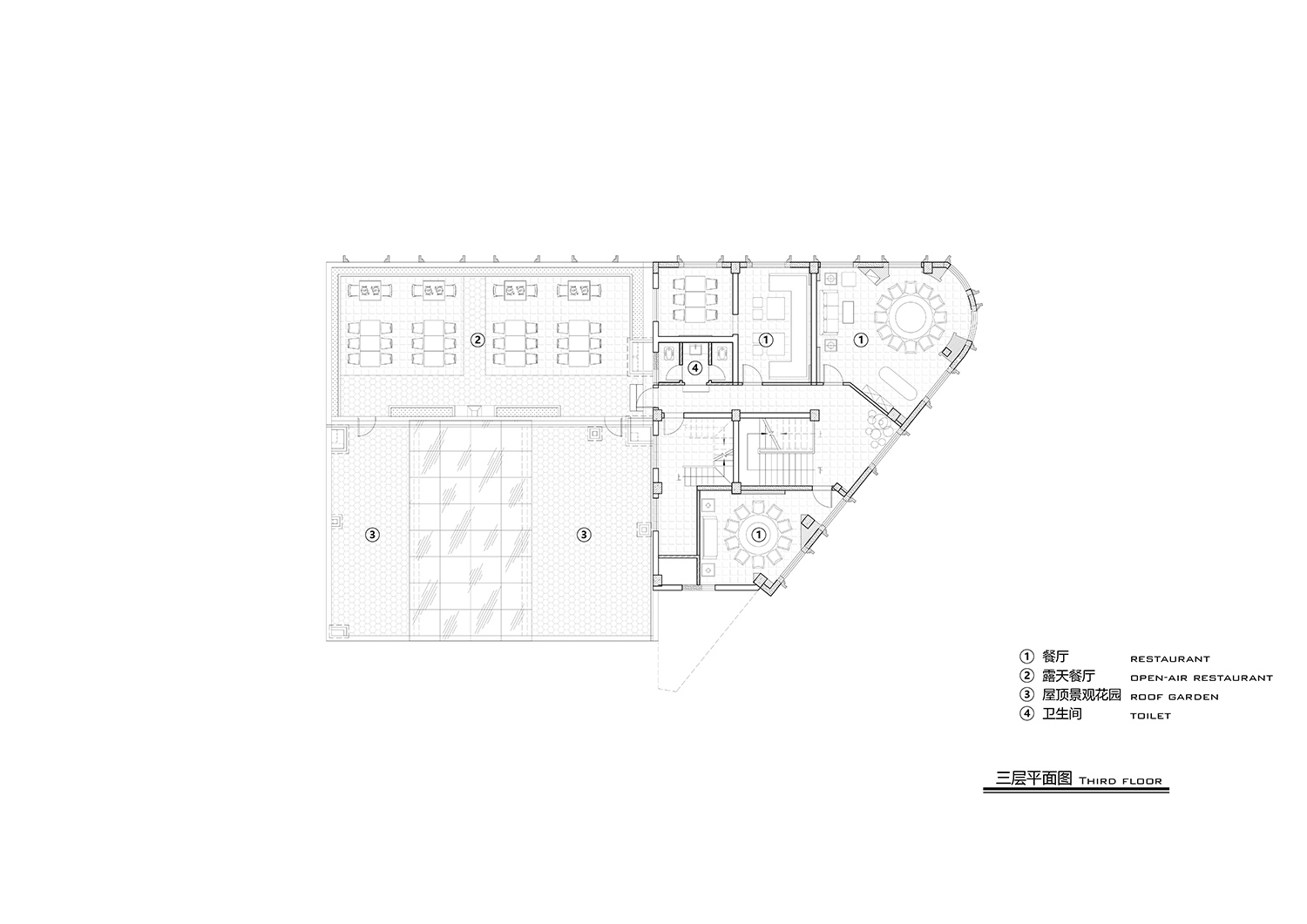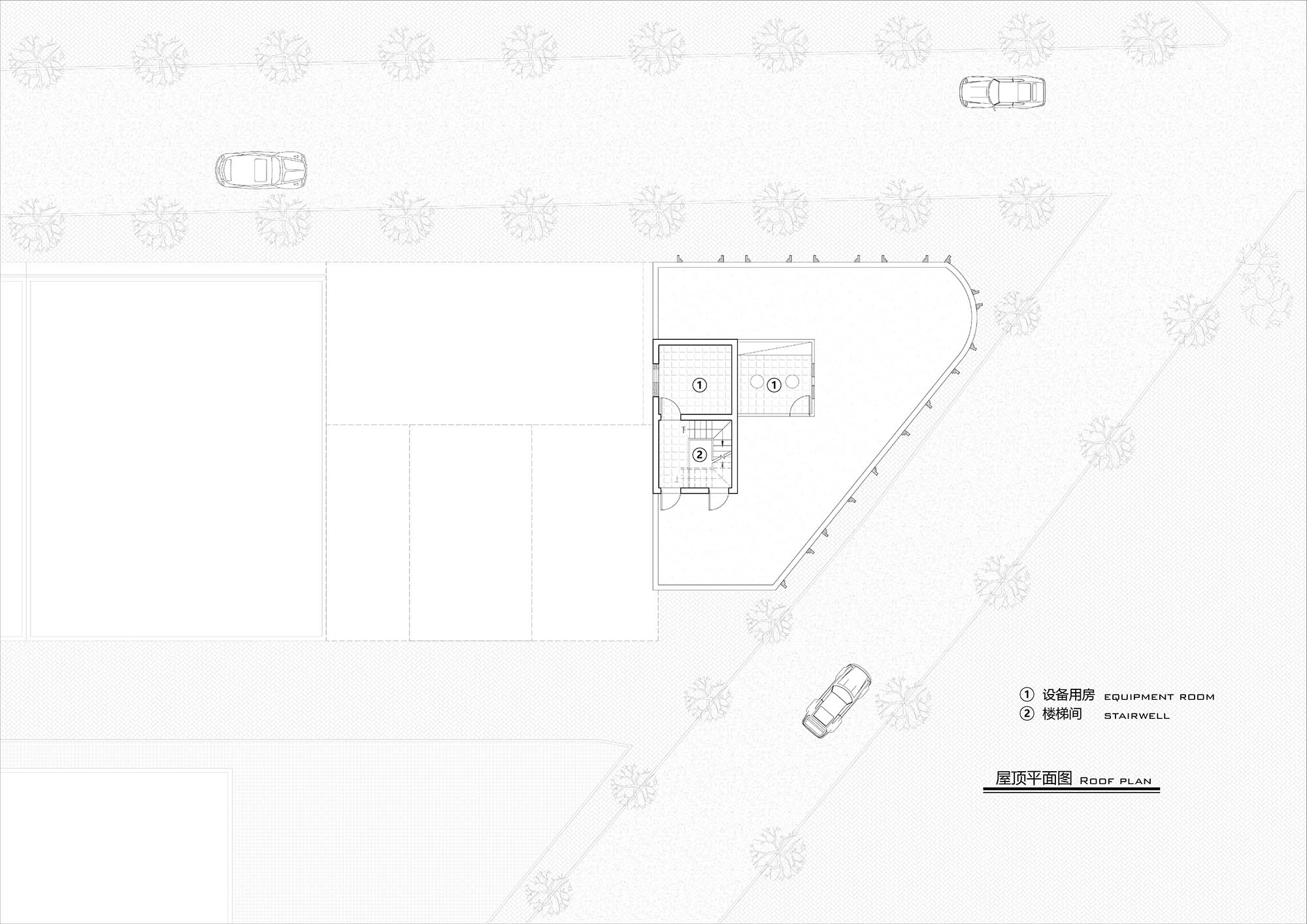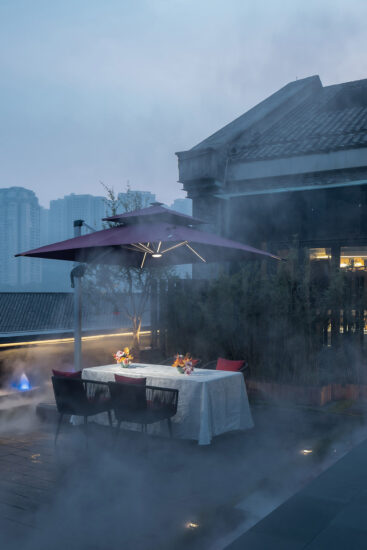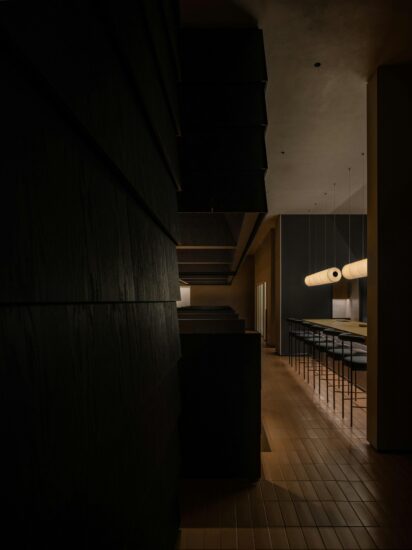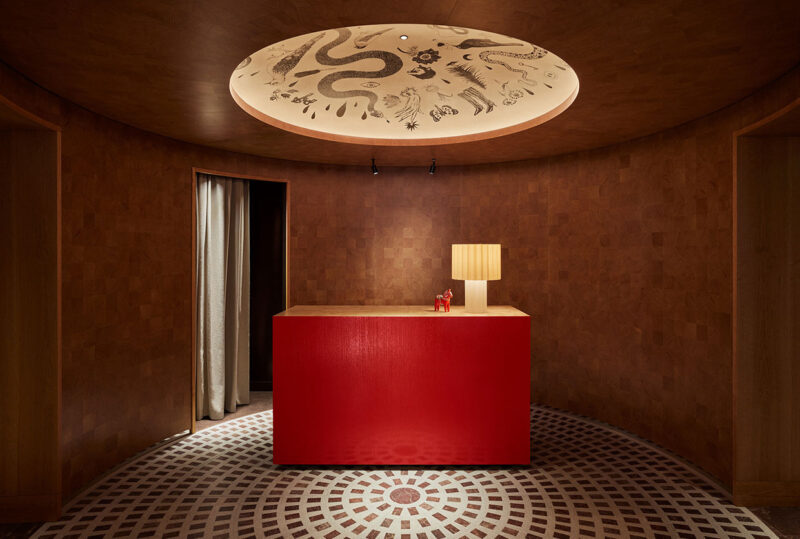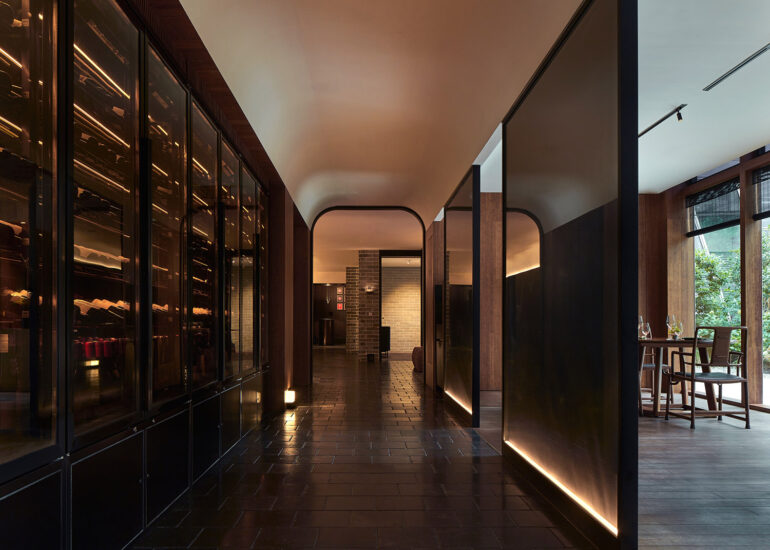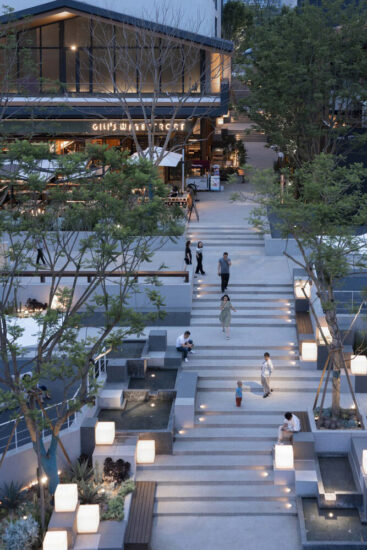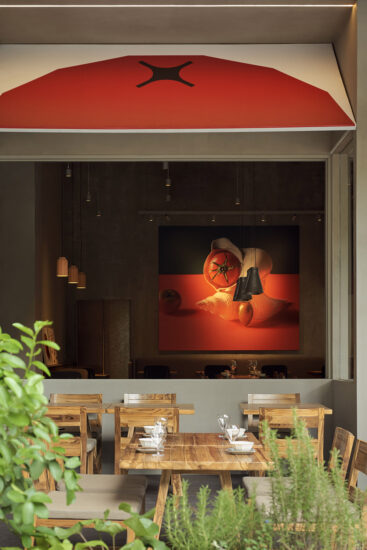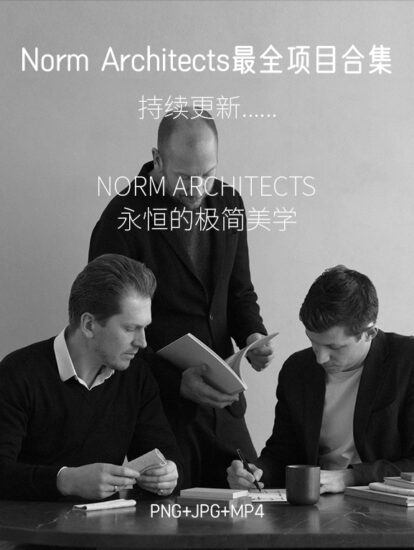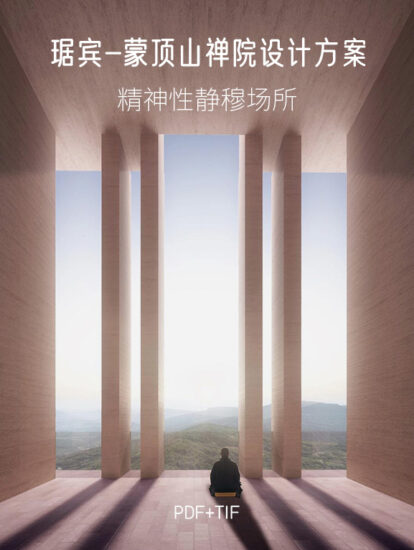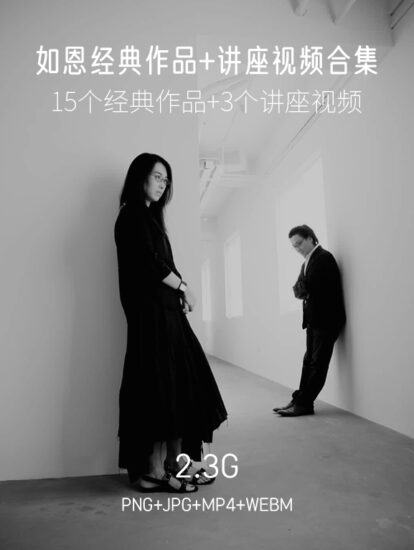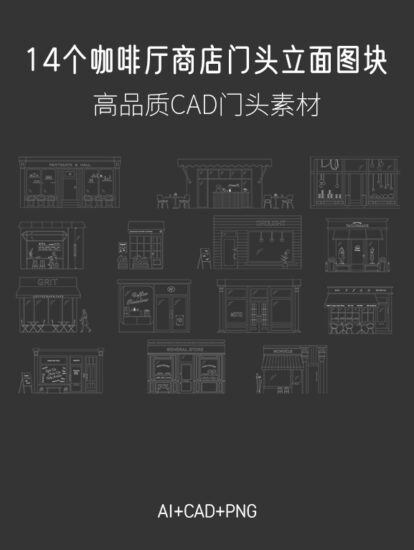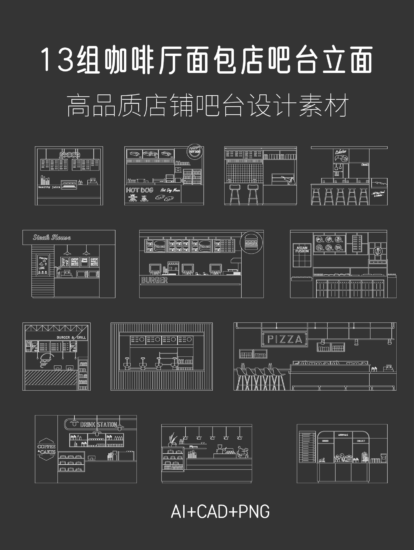全球設計風向感謝來自 平介設計 的餐飲空間項目案例分享:
∇ 遠看建築 ©紮西培楚
在喜馬拉雅山脈以東,有一係列南北走向的高山峻嶺,這就是中外聞名的三江並流的橫斷山脈地區。香格裏拉,地處三江並流腹地,作為曆史上茶馬古道的重鎮,不同民族文化在此交彙融合,造就了當地獨具特色的文化環境。從二十世紀初約瑟夫·洛克初次將橫斷山區展現於世界前,再到詹姆斯·希爾頓筆小說裏的淨土,香格裏拉以其自然風光與民俗文化吸引著世界各地的旅客來此尋找心中的家園。
In the northwestern part of Yunnan Province, in the Hengduan Mountains, there is a mysterious and tranquil place called “Shangri-La”. This place Located in the hinterland of the Three Parallel Rivers, it was once an important town on the Ancient Tea Horse Road. The integration of multiple ethnic groups has created a unique local cultural environment, attracting tourists from all over the world to find their homes in their hearts. At the beginning of the 20th century, the Hengduan Mountains were first shown to the world through the explorer Joseph Charles Francis Rock. In the 1930s, “Shangri-La” appeared in James Hilton’s novel “Lost Horizon”. The pure land depicted in the book was longed for by the world, and make Shangri-La known to the world.
項目定位與策劃 Programming
∇ 項目位置 ©平介設計
∇ 老喀拉卡爾藏餐廳照片 ©紮西培楚
二十年前,一戶名叫白瑪的家庭在香格裏拉獨克宗古城外城區開了第一家藏餐廳,這家名叫喀拉卡爾藏餐廳虔誠的追求“在’溫暖’的香格裏拉,開一家溫暖的店,等候一群溫暖的人來”的理念,生意追求不溫不火為度,誠信真實食材為底。
Twenty years ago, a Tibetan family named Pema opened the first local Tibetan restaurant “Karakal” in the outer urban area of the ancient city of Dukezong, Shangri-La. Karakal pursues to protect the authenticity with care.Keeping the business moderate, and the food ingredients are natural. Always adhere to the concept of “open a warm store in the warm Shangri-La, and wait for a group of warm people to come”.
二十年後的今天我們希望以白瑪·喀拉卡爾的積澱為基礎,展現香格裏拉獨特的地域文化,設計改造一個新的複合空間,一個能讓旅客品嚐到香格裏拉原真的藏族美食的舒適餐廳。同時,我們設想這個空間也是香格裏拉各界文化人士相聚與交流的家園。這裏可為諸如文化沙龍,攝影展,座談會等各類文化活動提供場所。通過舒適優雅的環境與豐富的文化活動將大家連接在一起,期待文化與思想的交流能夠迸出精彩的火花。
Today, twenty years later, we are designing and transforming a new composite space, hoping to use the accumulation of Pema Karakar as the starting point and the most authentic Tibetan cuisine as the medium to show the regional cultural characteristics of Shangri-La. At the same time, we envision this space as a home for local people from all walks of life in Shangri-La to gather and communicate. It can provide venues for various cultural activities such as cultural salons, photography exhibitions, and symposiums. Serving the cultural life of the local people through a comfortable and elegant environment. We looking forward to the exchange of culture and ideas can burst out wonderful sparks.
建築改造 Architectural Transformation
∇ 外立麵夜景 ©紮西培楚
場地由兩部分組成:三層餐廳及兩層庭院式住宅。現有三層建築為十年前建成,旁邊的老宅為九十年代所建,老建築為10年前業主自建的磚混建築,存在立麵造型與所在地文化環境不符,空間利用低並在冬季存在嚴重的保暖問題。
The site consists of two parts: a three-story restaurant and a two-story courtyard residence. The existing three-story building is a brick-concrete building built by the owner ten years ago, and the old residence next to it was built in the 1990s. The facade of the original building on the site does not match the local cultural environment, in the meantime the space utilization is low, and there are serious thermal problems in winter.
∇ 設計過程 ©平介設計
∇ 建築軸測圖 ©平介設計
在一個具有強烈地域性建築文化的環境裏如何以現代的手法,設計出一種既具現代感又蘊含藏地文化特色的空間形態與建築是貫穿項目始終的目標與挑戰。基於這個目標,設計團隊也考察了香格裏拉周邊諸多傳統建築與新建的口碑項目(梅裏既下山、阿若康巴酒店等)。受限當地政策(新城規劃對立麵風貌控製的要求)與項目預算,我們放棄了最初基於評估後認為結構不合理性提出的重建想法,轉向通過對建築外立麵及室內空間進行改造的方式,以增加本土文化特征並提升室內環境品質。而在整個過程裏我們嚐試打破當地對於建築盲目追求傳統元素與材料堆砌而忽視使用體驗的現狀,回歸並關注地域建築的樸素、內斂與溫暖,以及對使用體驗的尊重。
In a context with a strong regional architectural culture, how to use modern techniques to design a built environment that is both modern and contains Tibetan culture is the goal and challenge throughout the project. Based on this goal, the design team investigated a number of traditional buildings around Shangri-La and several newly built commercialprojects with favorable comment (MSunyata Hotel in Meili Snow Mountainn, Arro Khampa Hotel, etc.). Initially, we proposed an idea of reconstruction based on the assessment that the original building structure was irrational. However, due to local policies (requirements for the control of facades in new town planning) and project budgets, we gave up the idea of reconstruction and switched to adopting the renovation of external facade and indoor space. The renovation increase the local cultural characteristics and improve the quality of the built environment. At the same time, we also tried to break the current situation of blindly pursuing traditional elements and materials in the building and neglecting the use experience during the whole design process, and returning to the basic consideration of the use experience, focusing on the simplicity, restraint and temperature of the regional architecture.
∇ 建築街景 ©紮西培楚
∇ 建築街景雪景 ©紮西培楚
∇ 建築街景夜景 ©紮西培楚
建築外立麵改造運用了藏族傳統建築的門窗元素,包括藏式九宮格窗(藏語 稱 格尼)與飛子木窗頭(藏語 稱 八蘇),並使用退台形式的窗套營造傳統藏式建築門窗所具有的層次與韻律,所有窗戶均采用雙層中空玻璃和加厚型材以保證室內保溫效果。在窗頭與窗套的材料選擇上,我們使用了鏽蝕折形鋼板代替傳統的木材,以解決木材在高原室外環境下不耐久的問題。外牆塗料使用了淡夯土黃真石漆來製造傳統藏房的夯土牆的粗糙紋理質感,通過對傳統元素的現代演繹,采用在地成本可控的現代用料以回應當地居民對地域建築的“記憶”。在立麵照明設計上我們同樣避免使用直射光源而采用底部和凹槽打燈去突顯材料和立麵的質感。
The renovation of the external façade of building uses the door and window elements of traditional Tibetan architecture, including Tibetan-style lattice windows and wooden window heads, and use of window trim in the form of setbacks in order to create the rhythm of traditional Tibetan building doors and windows. In consideration of the plateau climate, all windows use double-layer hollow glass and thicker glass frames to ensure indoor thermal insulation. In the material selection of window head and window trim, we used rusty steel plate instead of wood to solve the problem that wood is not durable in the outdoor environment of plateau. The exterior wall was painted by pale rammed earth yellow real stone paint to create the rough texture of the rammed earth walls of traditional houses. Through the modern interpretation of traditional elements and use of modern materials with controllable costs we were able to respond to the “memory” of local residents to regional buildings. In the design of facade lighting, we also avoid using direct light sources and use bottom and groove lighting to highlight the texture of materials and the form of external facades.
室內改造與設計 Interior Renovation
∇ 建築剖麵圖 ©平介設計
∇ 建築模型 ©平介設計
∇ 施工過程 ©紮西培楚
室內改造的需求是要增加使用麵積,改變原有功能並改善原有不合理的布局,同時提升整體環境。在整體功能布局上,一樓作為新擴張的空間用於開拓針對年輕人的新餐飲業態(酥油下午茶、自助藏餐、本地自釀酒吧),二樓保留原有功能(吧台和開放式餐廳),通過調整布局改善餐廳空間利用,三樓通過重新梳理交通流線與空間布局改造為包間層並提升私密性以應對傳統藏餐就餐習慣。
The primary requirement of interior renovation is to increase the usable area, and the second is to improve the overall environment while improving the original functions and spatial layout. In terms of the overall functional layout, the first floor is used as a newly expanded space to develop new catering formats for young people such as afternoon tea, self-service Tibetan food, local craft beer bar. The second floor maintains the original functions (bar counter and open restaurant), to improve the use of restaurant space by adjusting the layout. The third floor was transformed into a private room floor by reorganizing the traffic flow and spatial layout, and enhancing privacy to echo the dining habits of traditional Tibetan meals.
∇ 餐廳入口 ©紮西培楚
∇ 餐廳一層 ©紮西培楚
原建築一樓為臨街鋪麵,多數時間處於閑置狀態,我們將原有臨街鋪麵打通使一層擁有了開敞的空間,在受限於原始結構無法全部拆除牆體的位置,我們通過在兩側牆體開門並使用鋼質門套作為結構加固,使該部分形成了一個新的門廳,我們在此設置新的入口作為餐廳次入口,並增加衛生間使一層可作為功能完整的獨立空間使用。通過重新布局廚房送餐流線將原廚房出口移位與主入口分開,解決了之前廚房出口與餐廳入口在高峰期衝突的問題,讓餐廳主入口有一個完整的前廳。
The first floor of the original building was street-facing shops, which was idle most of the time. We opened up the original street-facing shops by removing the partition wall, so that the first floor has a new open space. In the shop where the wall cannot be completely demolished due to the original structure, we opened doors on both sides of the wall and used steel door sleeves as structural reinforcement to formthe space as a new foyer. We set up a new entrance here as the secondary entrance of the restaurant, and added toilets so that the first floor can be used as an independent space with complete functions. By re-arranging the kitchen delivery flow line to separate the original kitchen exit from the main entrance, the conflict between the kitchen exit and the restaurant entrance during the peak period was solved, and the main entrance of the restaurant has become a complete front hall.
∇ 火塘空間 ©紮西培楚
∇ 餐廳一層 ©紮西培楚
在康巴地區的傳統藏房裏,火塘是一家人日常生活的中心。在一樓弧形空間處,我們以藏族傳統的火塘為原型做了現代的演繹與表達,以重現藏房裏大家圍爐喝茶、圍爐而話的生活感,以呼應當地居民的傳統生活場景。
In the traditional houses in the Kham region, the fire pond is the center of the family’s daily life, and many life scenes take place around the fire pond. In the arc-shaped space on the first floor, we made a modern interpretation and expression based on the traditional Tibetan fire pond, to reproduce the sense of life in thetraditionalhouse that families drinking tea and talking around the fire pond, which echoing the traditional life scenes of local residents.
∇ 餐廳一層 ©紮西培楚
原建築天花橫梁的方向與高度關係較為混亂,是設計過程中很難處理的部分。受限於橫梁走向與高度,加之受到經幡飛舞和藏族生活中銅器的啟發,我們放棄了最初用吊頂隱藏橫梁的想法,在一樓使用金屬垂簾圍繞火爐做向外輻射的弧形垂簾,隱藏了混亂梁位的關係。同時我們將垂簾的高度設置由周圍向火爐逐漸降低,在視覺上與火爐的煙罩相融合,讓地麵與天花板的產生聯係。
The relationship between the direction and height of the ceiling beams of the original building is rather chaotic, which is a difficult part of the design process. Limited by the direction and height of the beams, and inspired by the flying of prayer flags and the copper-ware in Tibetan life, we abandoned the original idea of concealing the beams with a suspended ceiling, and used a metal curtain to surround the fire pond as an arc curtain on the first floor, by which we were able to hide the chaotic relationship of beams. At the same time, we set the height of the curtain to gradually decrease from the surrounding to the stove, visually blending with the Smoke hood, so that the ground and the ceiling are connected.
∇ 餐廳二層 ©紮西培楚
二樓是原餐廳的主要經營空間,也是許多人對餐廳曾經的記憶所在。在二樓的設計上我們盡量保留原室內布局。我們在桌椅的選擇上采用了與原來相同的桌椅形式,以求保留其原有的空間感受。我們采用藏族傳統的矮桌與坐榻,其高度能讓使用者處於一種自然的前傾姿勢從而營造出親近感。我們在桌椅的選擇上采用了與原來相同的桌椅形式,以求保留其原有的空間感受。天花設計上,我們則將金屬網垂簾平行排布,以呼應形狀與布局方正的藏式方桌與坐榻。
The second floor was the main business space of the original restaurant, and it is also a to memory the restaurant to customers. In the design of the second floor, we try to keep the original interior layout as much as possible, hence we adopted the same table and chair form as before, in order to retain its original spatial feeling. By using traditional Tibetan low tables and sitting couches, the height of users to be in a natural forward-leaning posture to create a sense of closeness. As for the ceiling, we arrange the metal mesh curtains in parallel to echo the square Tibetan table and seat with its square shape and layout.
∇ 餐廳大包間 ©紮西培楚
∇ 餐廳小包間 ©紮西培楚
原建築三樓主要作為相對私密的包間層使用,但因缺少硬性隔斷存在私密性不強的問題。受製於三樓無法拆除的承重磚牆結構,我們通過與在牆體開門洞加鋼製門套支撐結構的形式,重新布局了三樓的交通流線,利用原有牆體和新的輕質隔牆,分割出了三間彼此隔離並帶有休息區的包間,並增加了中性洗手間以增強整個三樓的私密性,解決了此前二樓與三樓共用洗手間的情況。
The third floor of the original building was mainly used as a relatively private compartment layer, but due to the lack of rigid partitions, there was a problem of weak privacy. Constrained by the load-bearing brick wall structure on the third floor that cannot be removed, we re-arranged the traffic flow lines on the third floor by opening new door holes in the wall and adding steel door cover support structures. Using the original walls and the new light weight partition wall to divides three separate private rooms with a rest area, and adds a neutral toilet to enhance the privacy of the entire third floor, which solves the previous situation of shared toilets on the second floors.
室內陳設上也盡量采用了藏式特色擺件,如極具藝術代表性和宗教屬性的藏族傳統繪畫“唐卡”。唐卡因宗教屬性唐卡的掛放多為供奉用途,在包間裏我們使用了在藏文化中象征尊貴與敬畏的紅色作為懸掛唐卡背景牆。通過背景牆顏色與燈光,我們希望在利用唐卡做空間點綴的同時,傳達一種對藏文化的敬仰。
The interior furnishings also use Tibetan characteristic ornaments as much as possible, such as the traditional Tibetan painting Thangka, which is highly artistic and religious. Thangka with religious attributes are mostly used for enshrinement purposes. In the compartments, we used red, which symbolizes honor and awe in Tibetan culture, as the backdrop for hanging Thangka. Through the color and lighting of the background wall, we hope to convey a kind of respect for Tibetan culture while using thangka as space decoration.
∇ 街邊酥油燈 ©紮西培楚
∇ 外立麵細節©紮西培楚
∇ 公園視角 ©紮西培楚
地處藏區,施工期間並未受疫情影響,項目於2020年竣工已投入使用。此次改造有效汲取香格裏拉藏地文化特質,為當地基於城市控規和風貌控製的新城區建築設計提供了新的思路。走入餐廳,一股溫暖的氣息撲鼻而來,坐下來,喝一口酥油茶,夾一塊犛牛肉,吃一口糌粑,與同行之人細語交談。這裏不像拉薩朝聖一般充滿儀式感,取而代之的是日常生活的樸實與平凡。
The site is located in a Tibetan region and was not affected by the epidemic during the construction period. The project was completed in 2020 and has been put into use. This renovation effectively absorbed the cultural characteristics of Shangri-La, and provided new ideas for the local architectural design of new urban areas based on urban control regulations. Walking into the restaurant, a warm breath came to the nose. Sat down, took a sip of butter tea, ate a piece of yak meat and ascoop of Tsampa, and talked with others. Unlike the Lhasa pilgrimage which is full of ritual sense, instead it is the simplicity and ordinariness of daily life.
∇ 一層平麵圖
∇ 二層平麵圖
∇ 三層平麵圖
∇ 屋頂平麵圖
項目信息
項目名稱:喀拉卡爾藏族美食文化中心
項目類型:建築改造
項目地點:中國雲南省迪慶藏族自治州香格裏拉市安康巷4號
設計單位:平介設計、雲南福龍設計事務所有限公司
項目團隊:紮西培楚,楊楠,王乙童,李宗鍵
公司網站:www.parallect-design.com
聯係郵箱:info@parallect-design.com
建成狀態:建成
設計時間:2018年10月-2020年1月
建設時間:2020年1月-2020年10月
建築麵積:1000平方米
攝影:紮西培楚
Project Name: Kalakal Tibetan Cuisine and Culture Center
Project Type: Renovation
Project Location: 4 Ankang Lane, Shangri-La City, Diqing Tibetan Autonomous Prefecture, Yunnan Province, China
Design team: Parallect Design, Yunnan Fulong Design Office Co. Ltd
Design Team: Peichu Zhaxi, Nan Yang, Yitong Wang, Zongjian Li
Website: https://www.parallect-design.com/
Contact e-mail: info@parallect-design.com
Type: built
Design:2018.10-2020.01
Construction: 2020.01-2020.10
Area: 1000 sqm
Photo: Peichu Zhaxi


